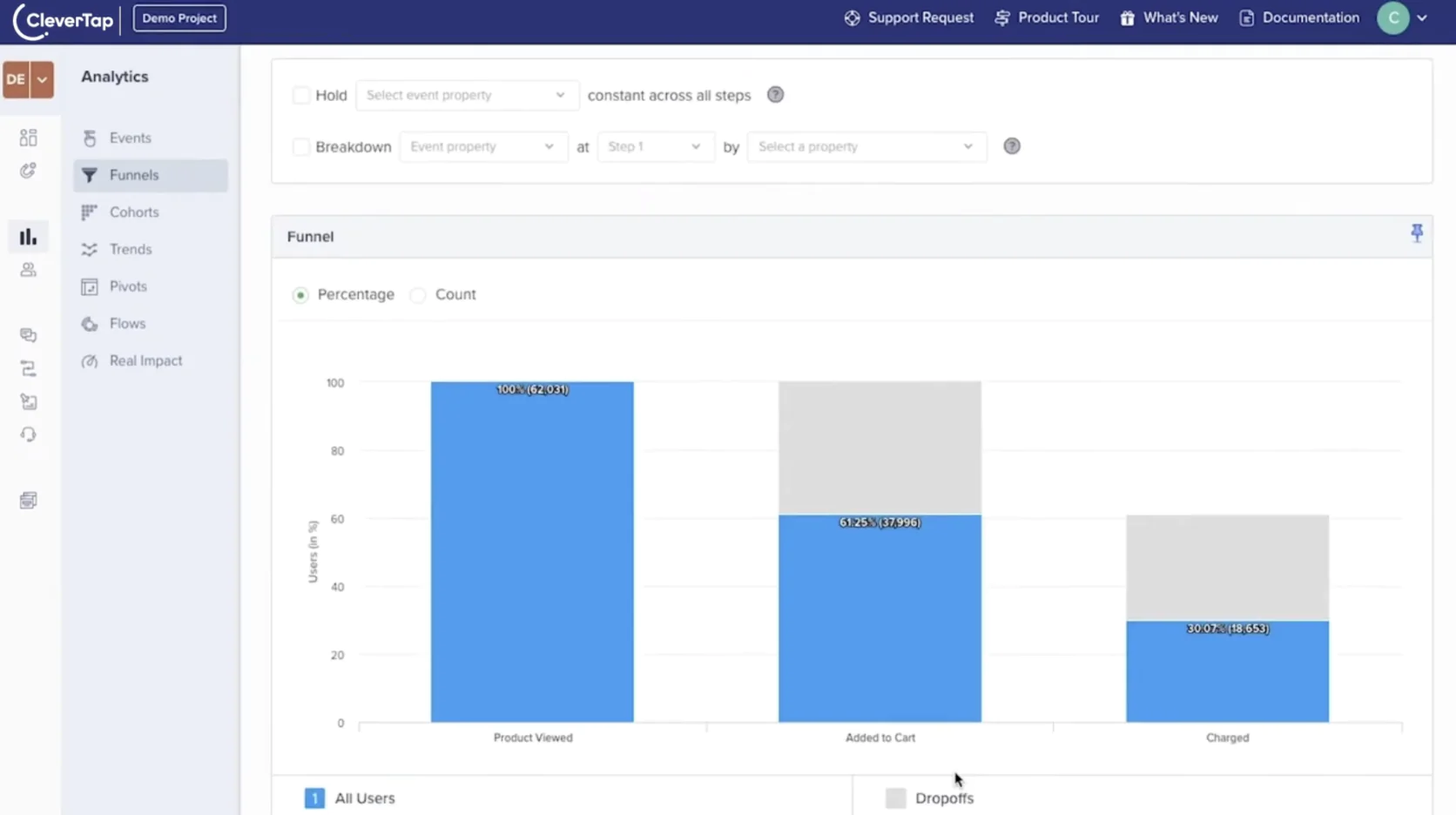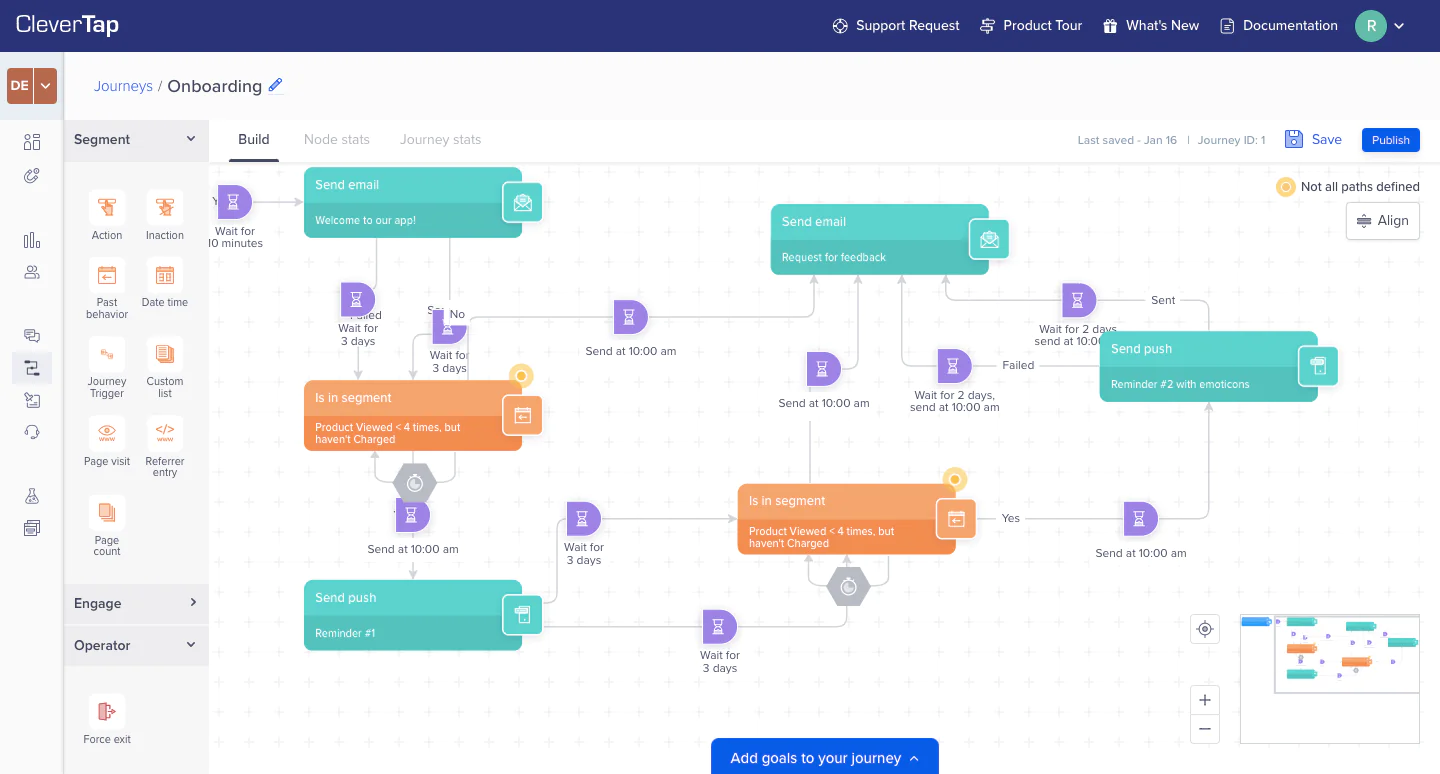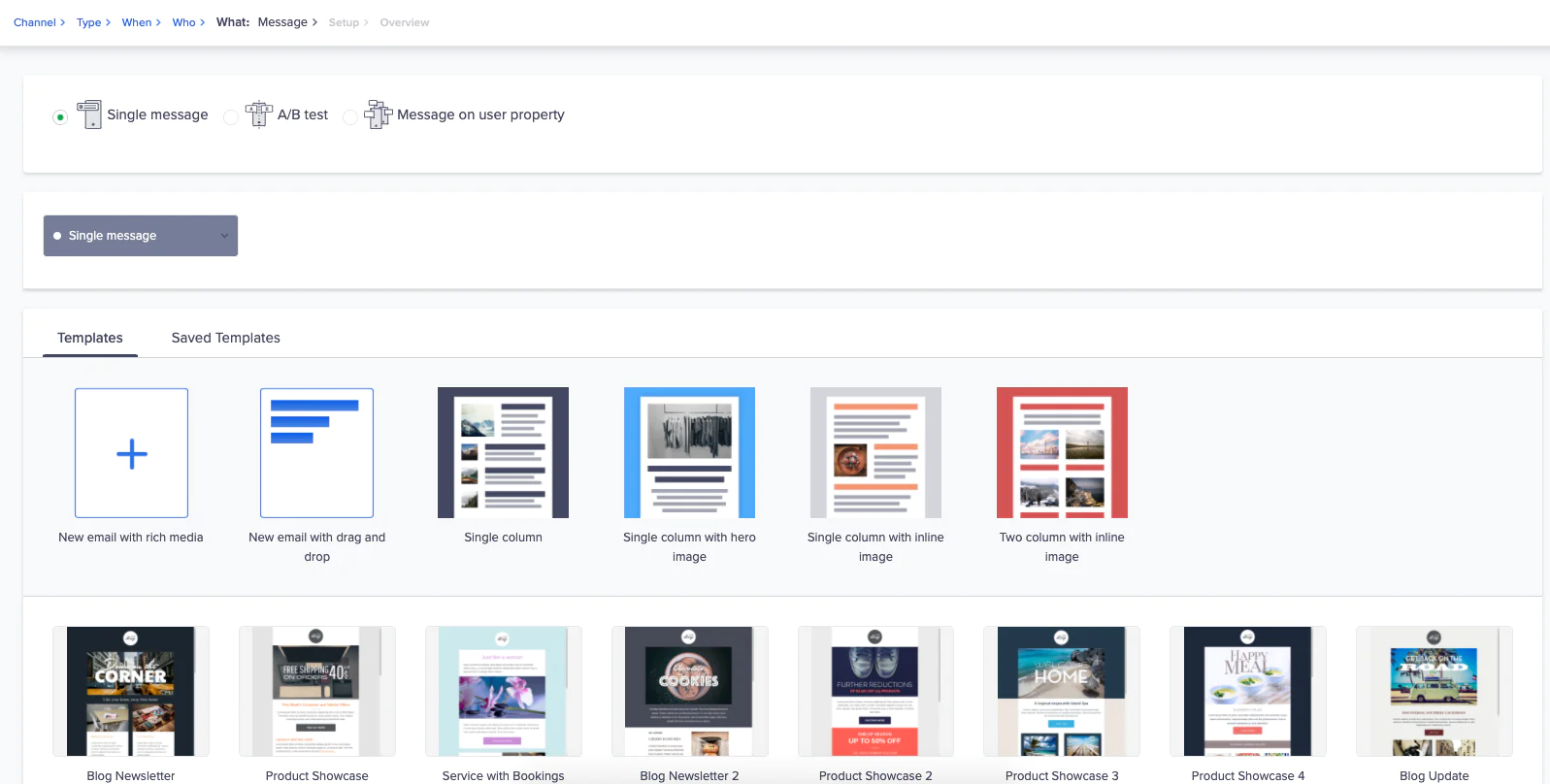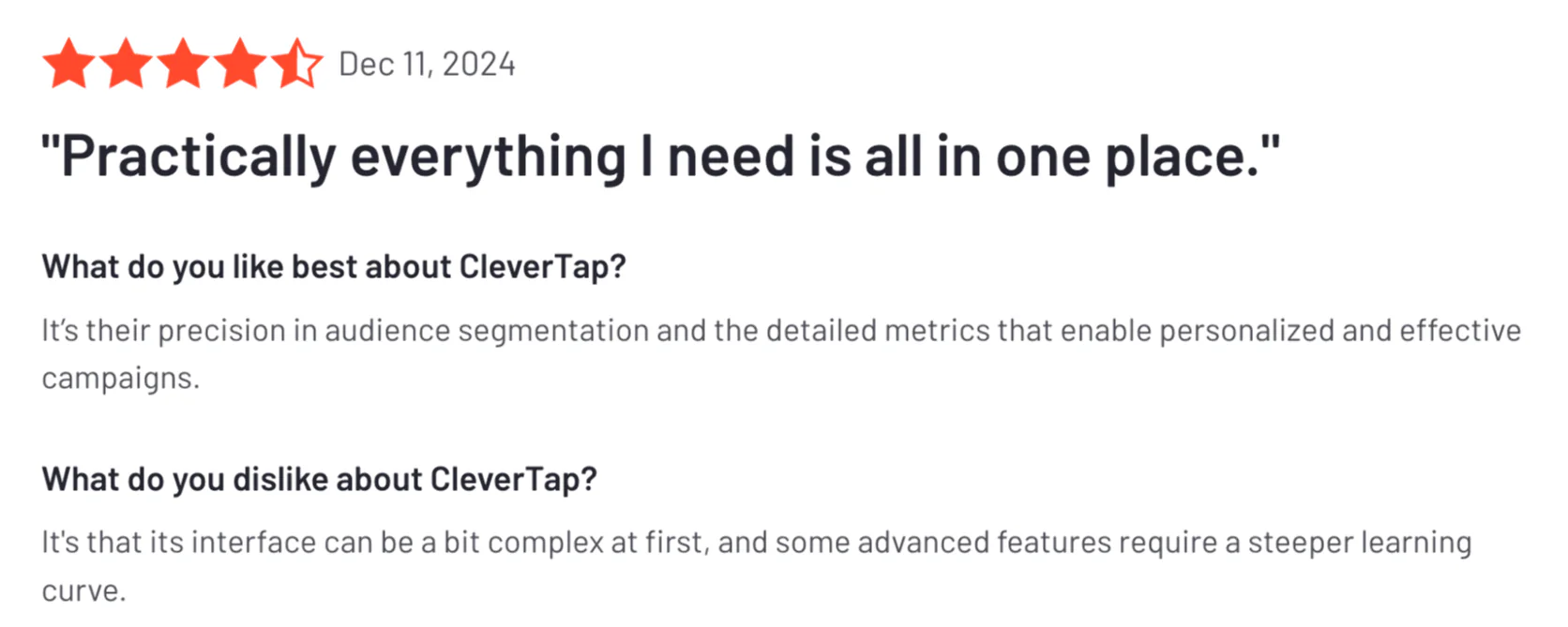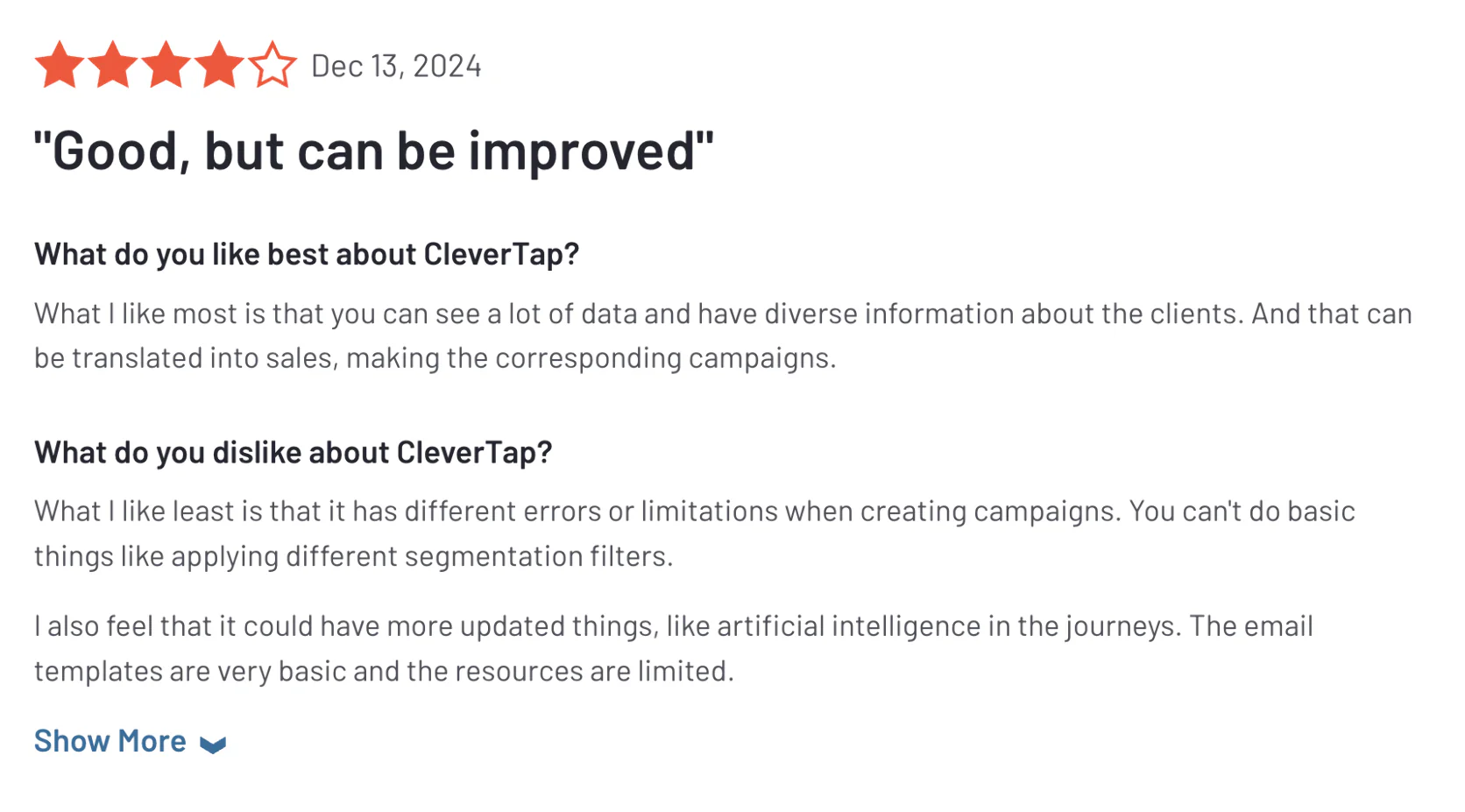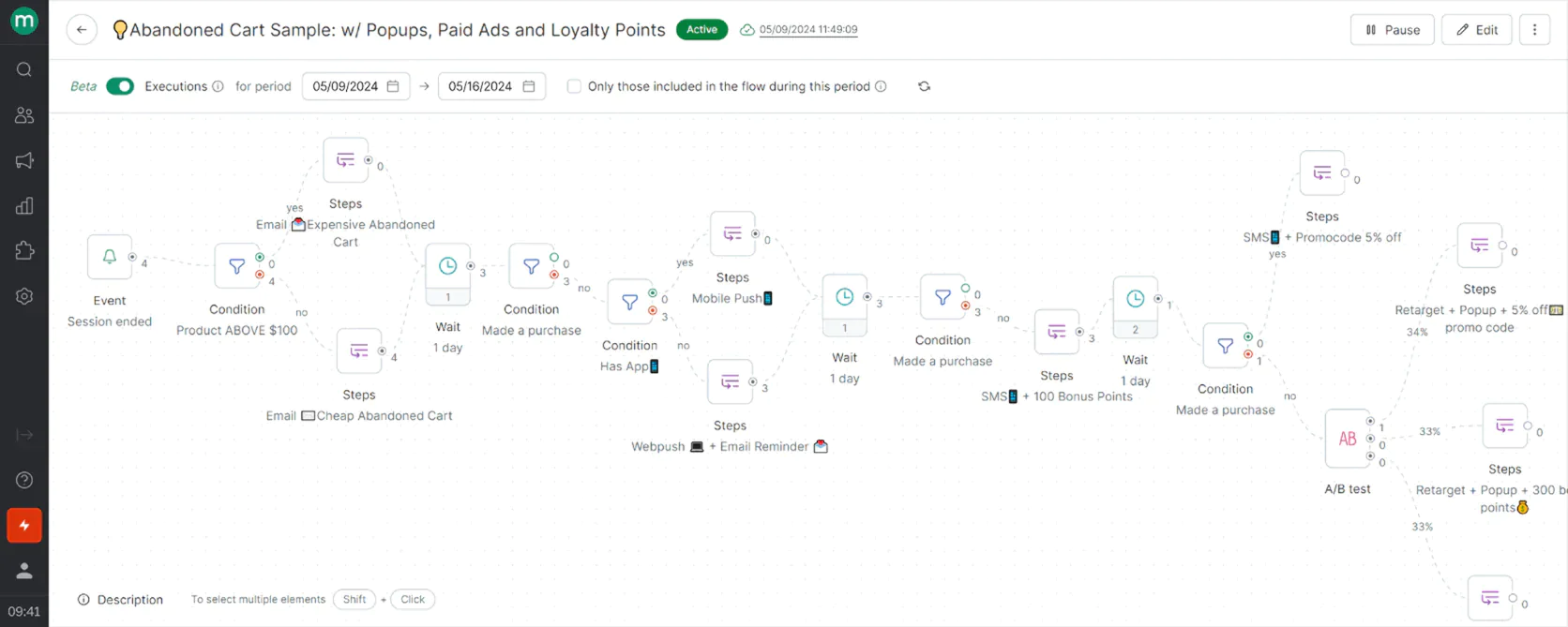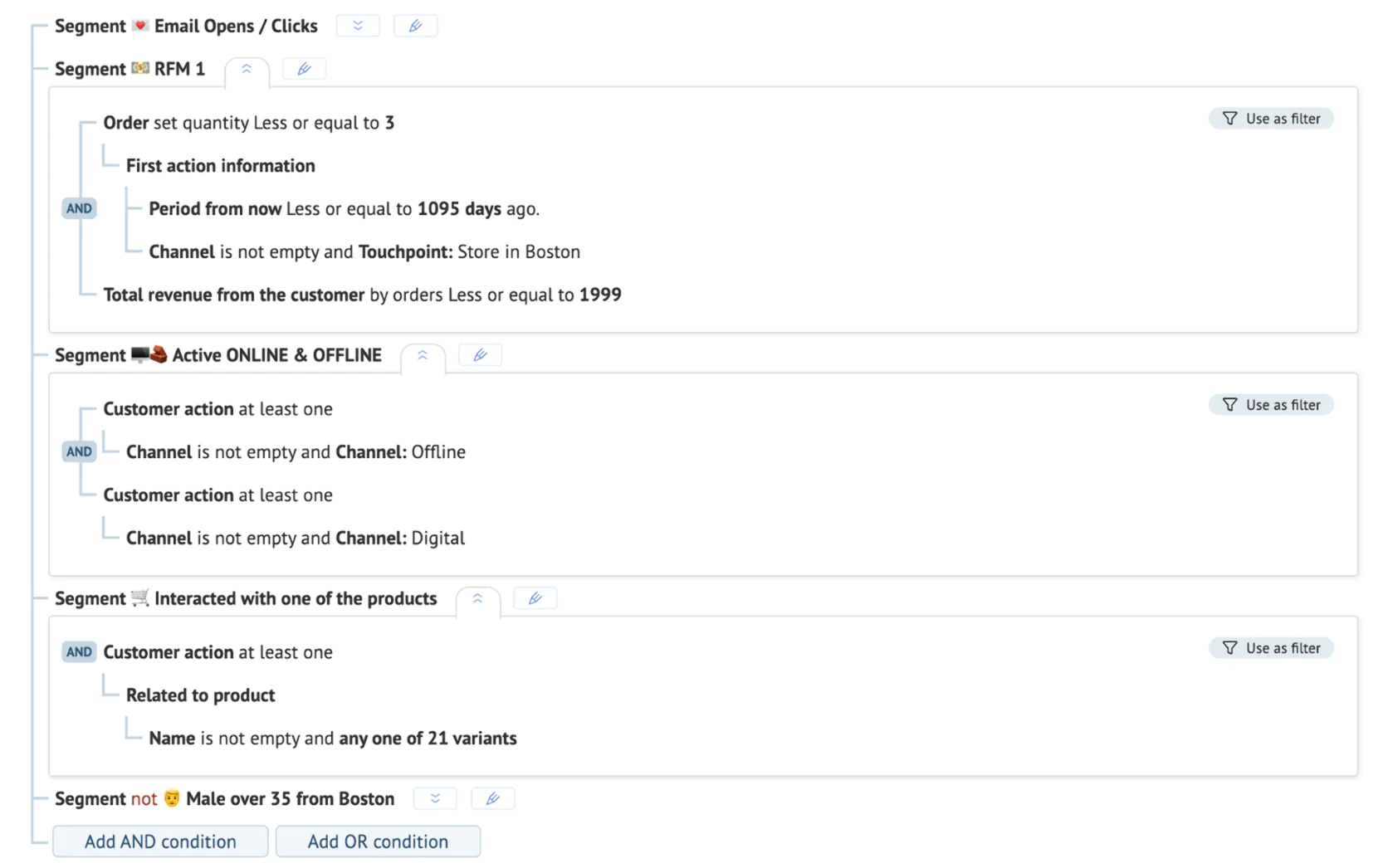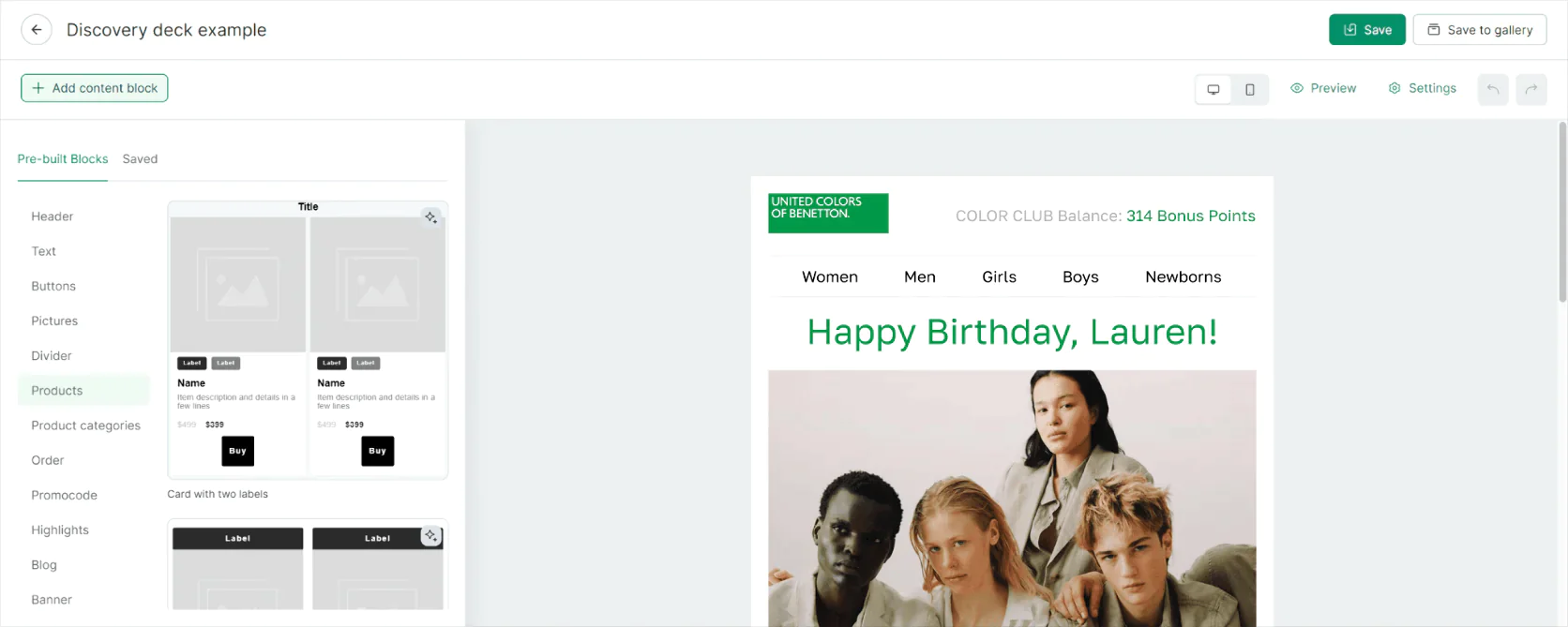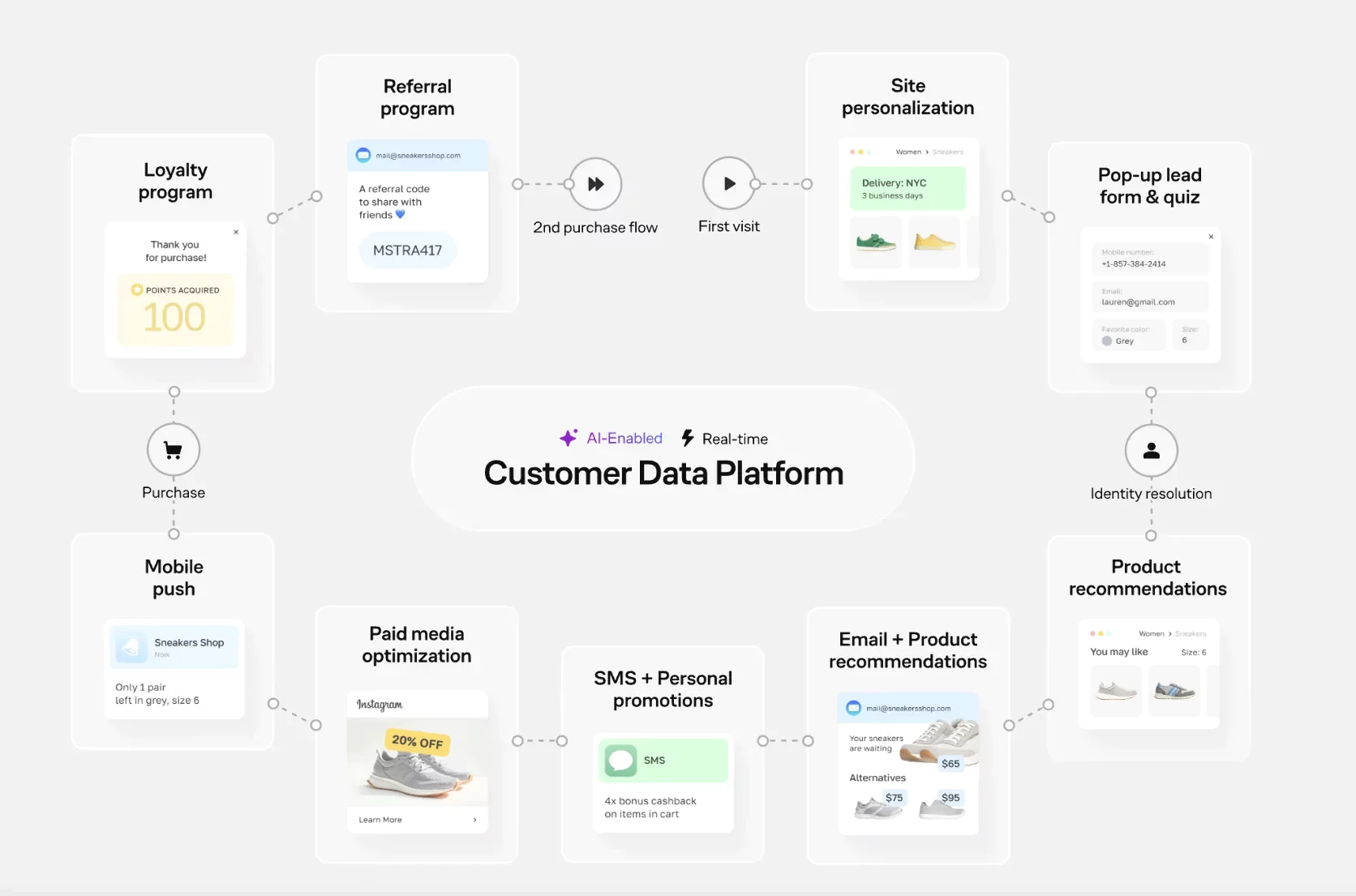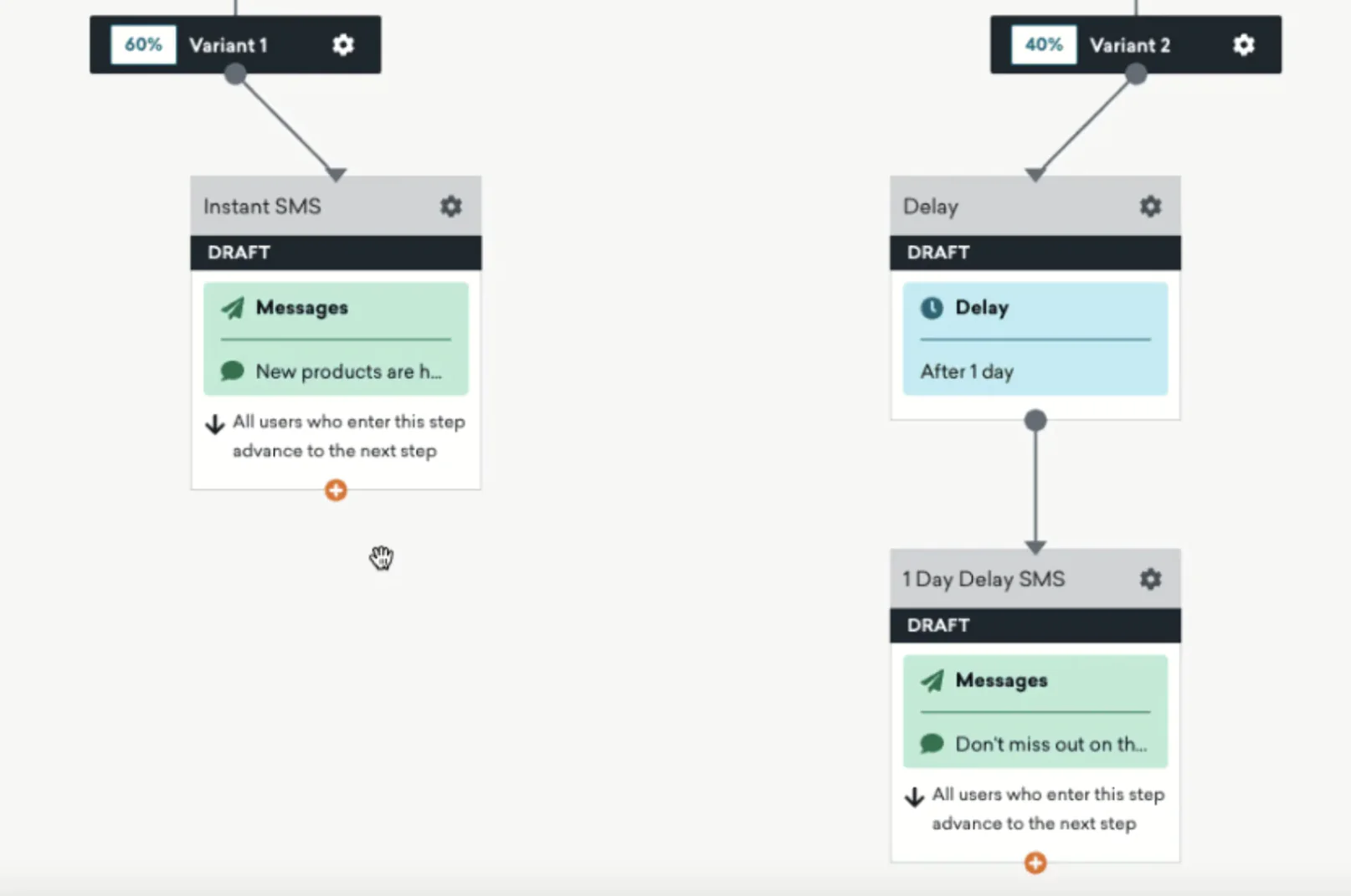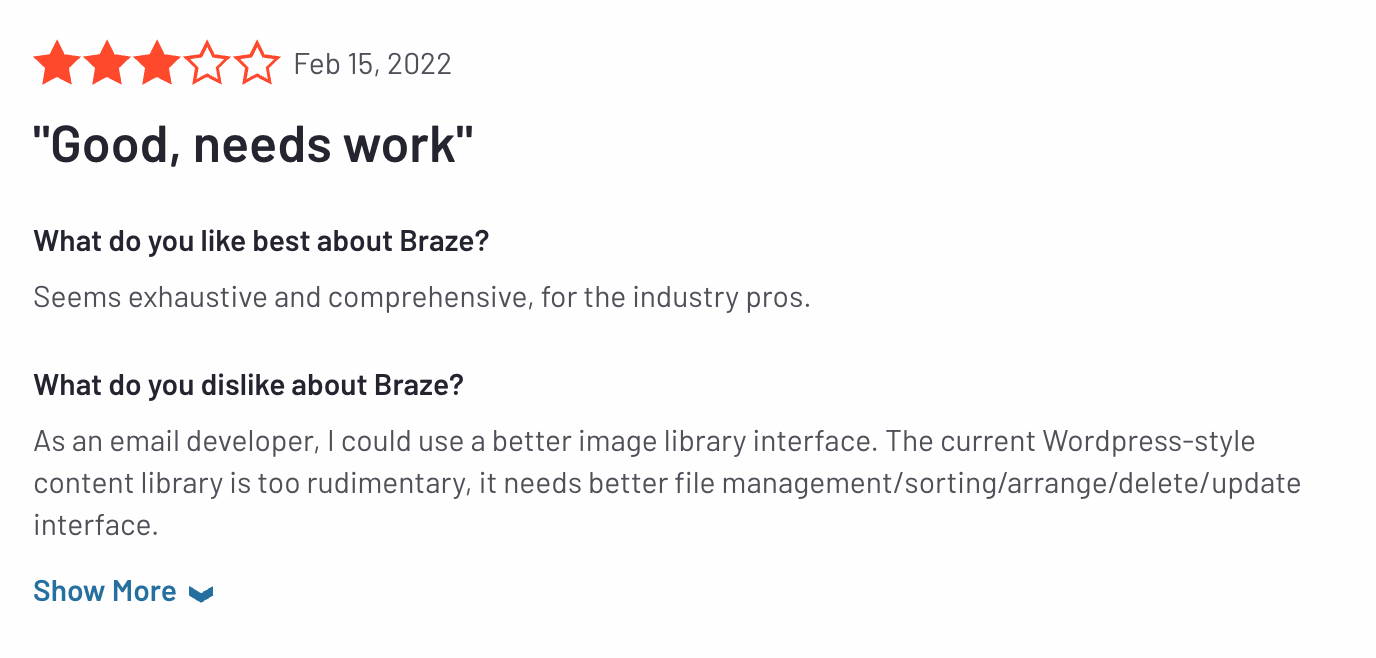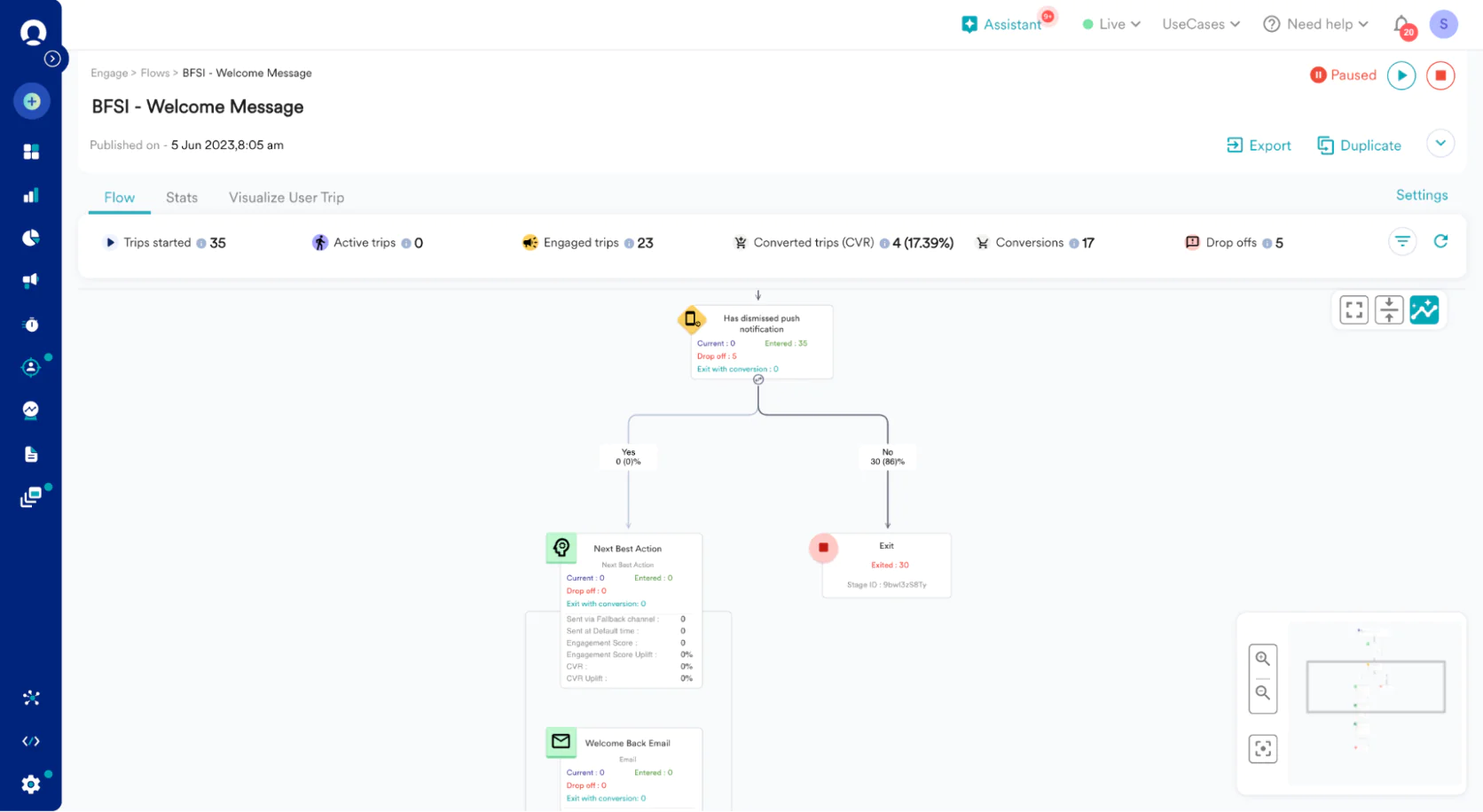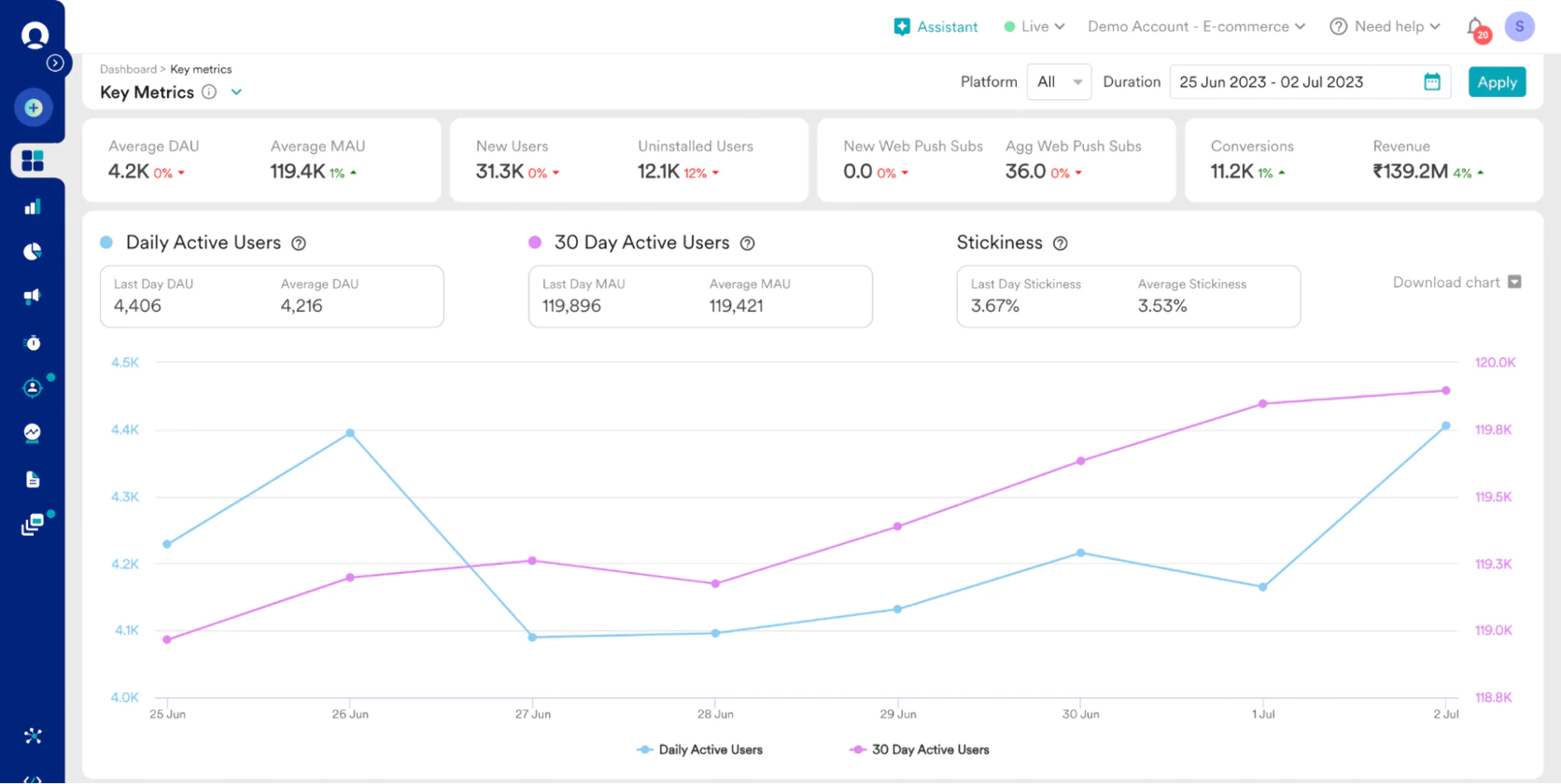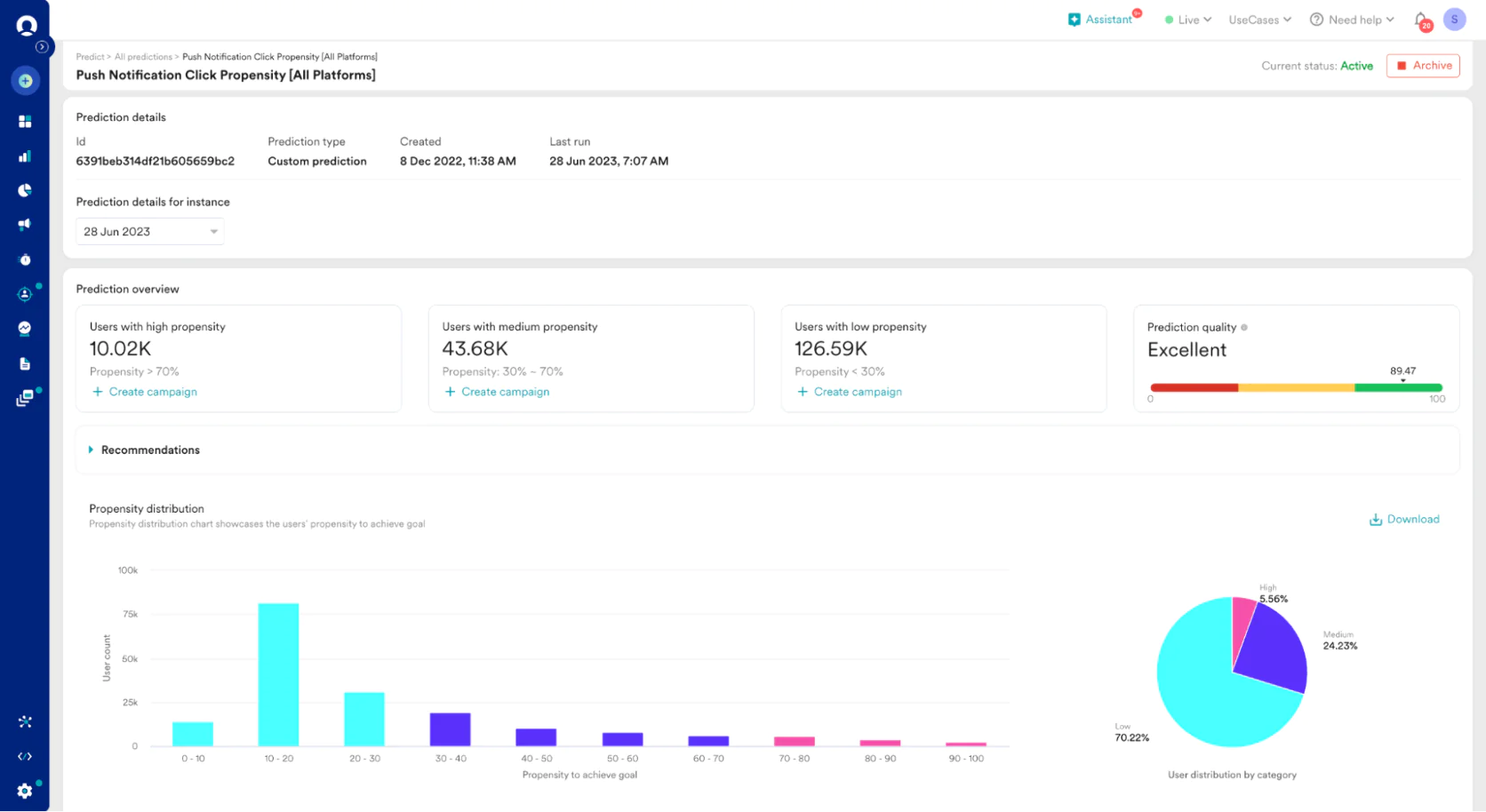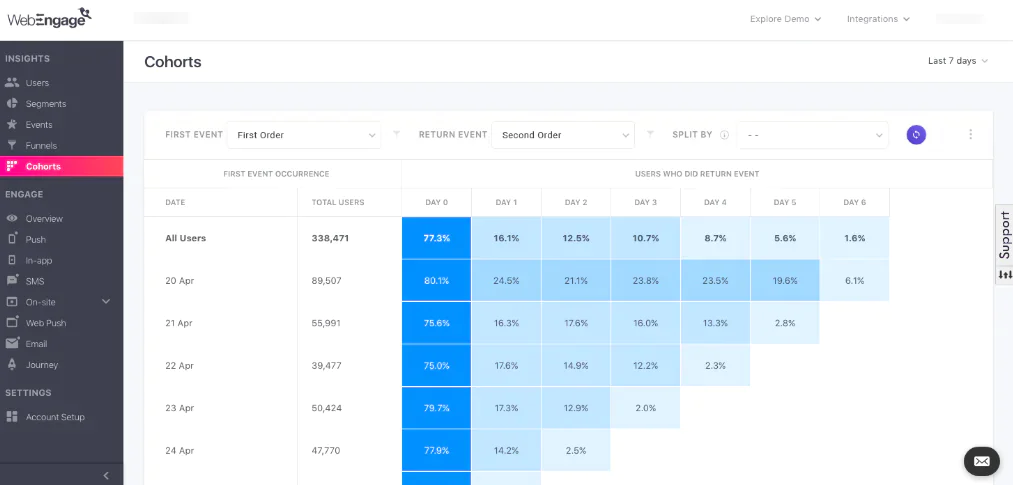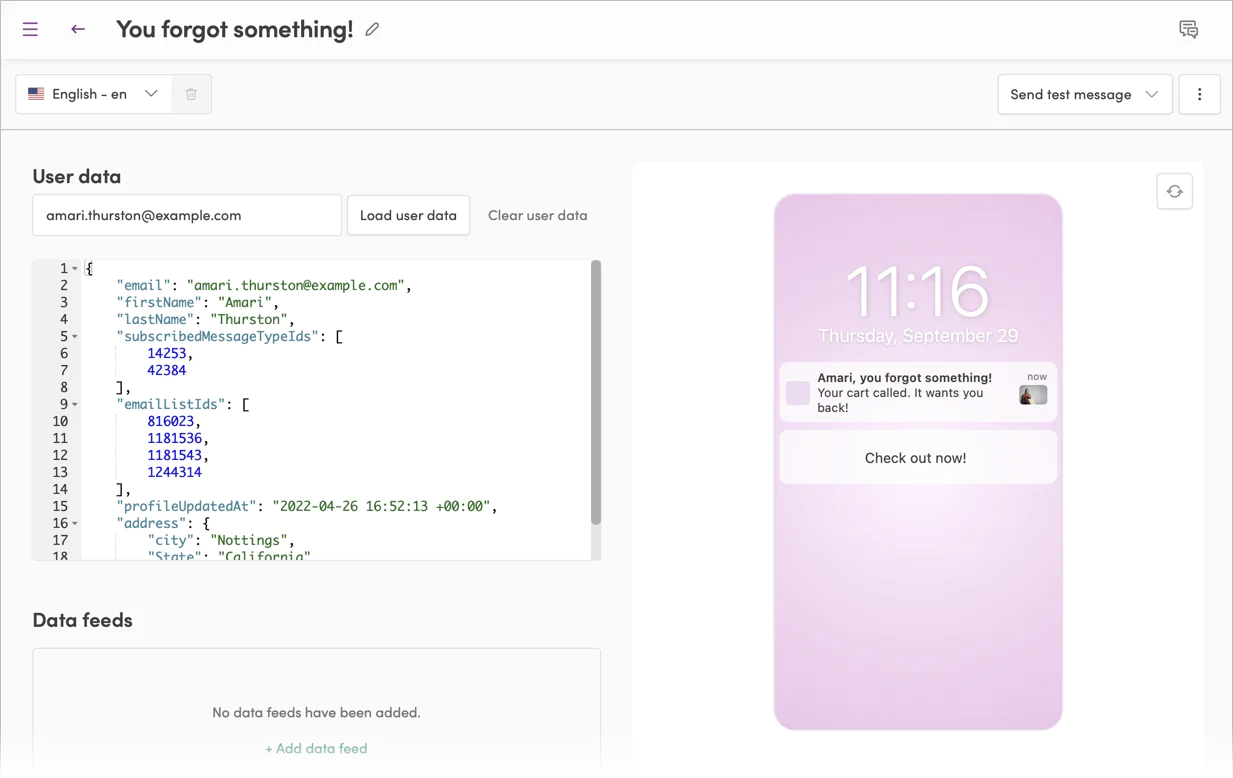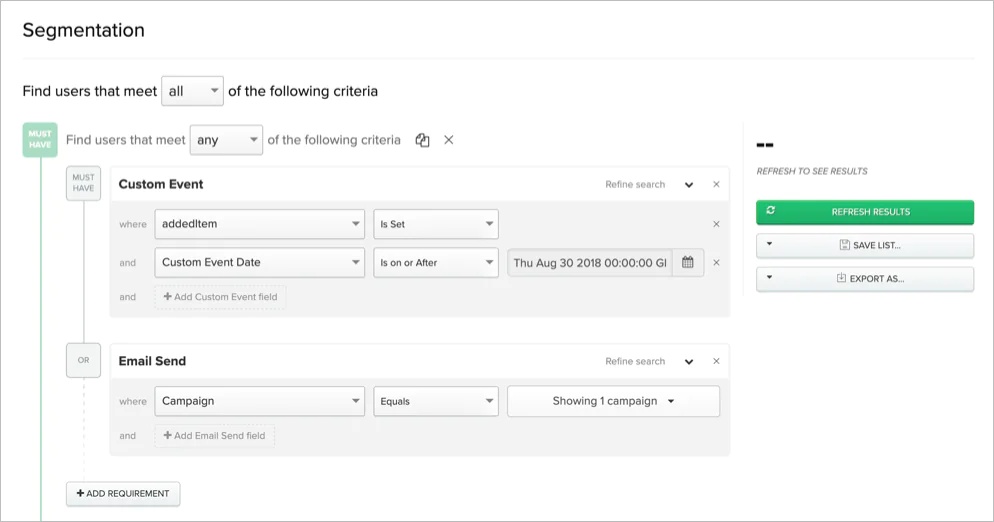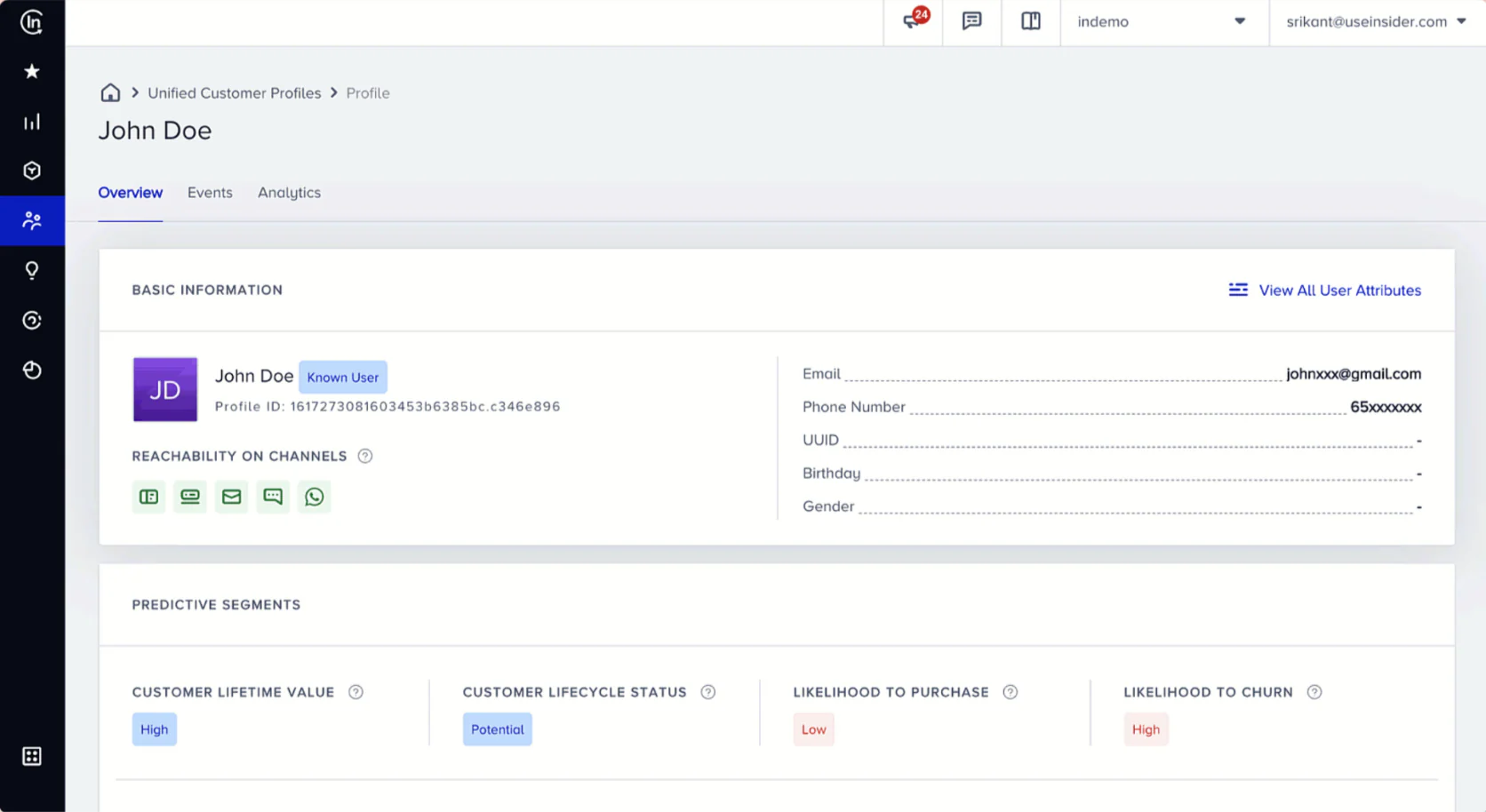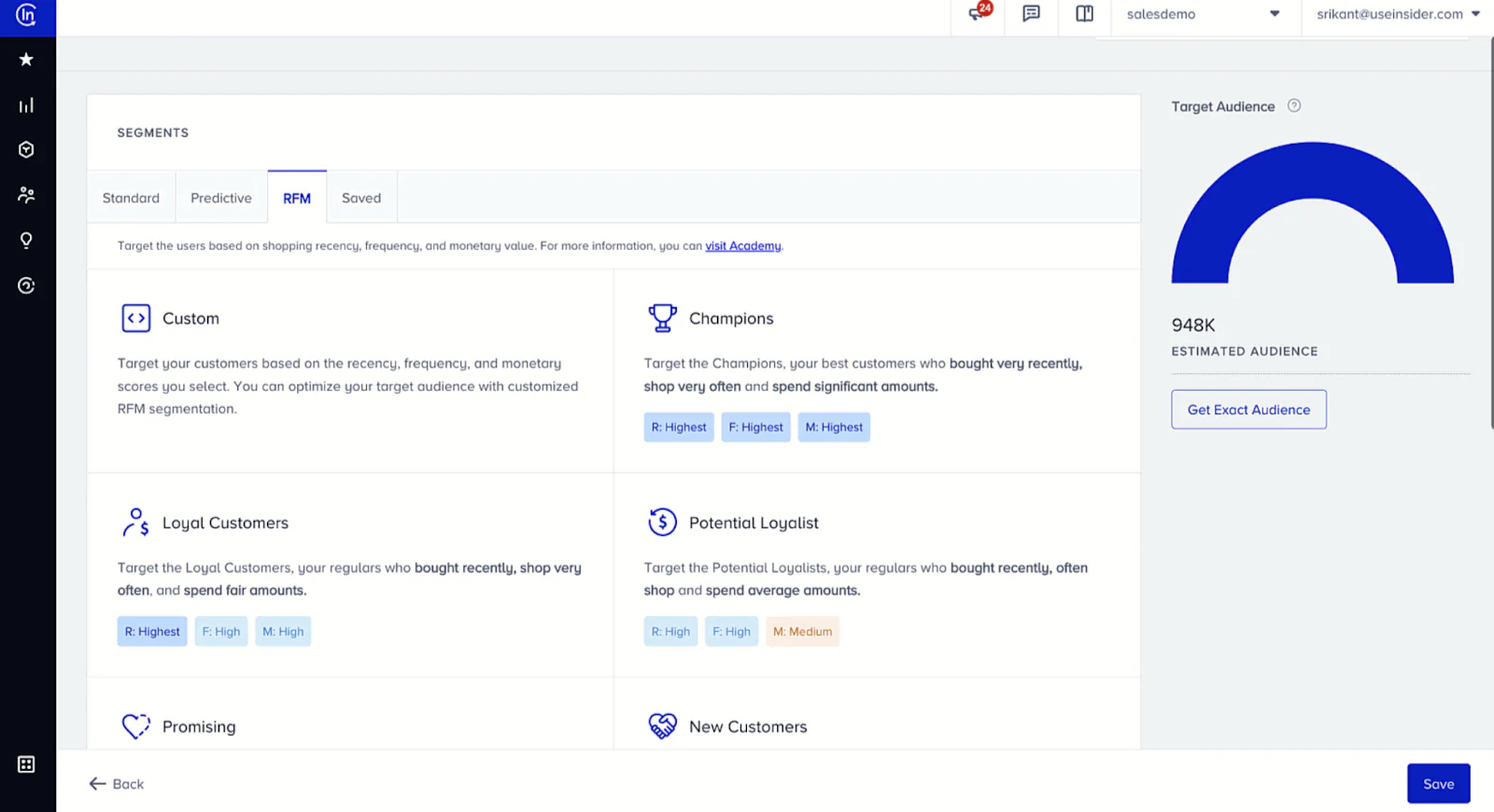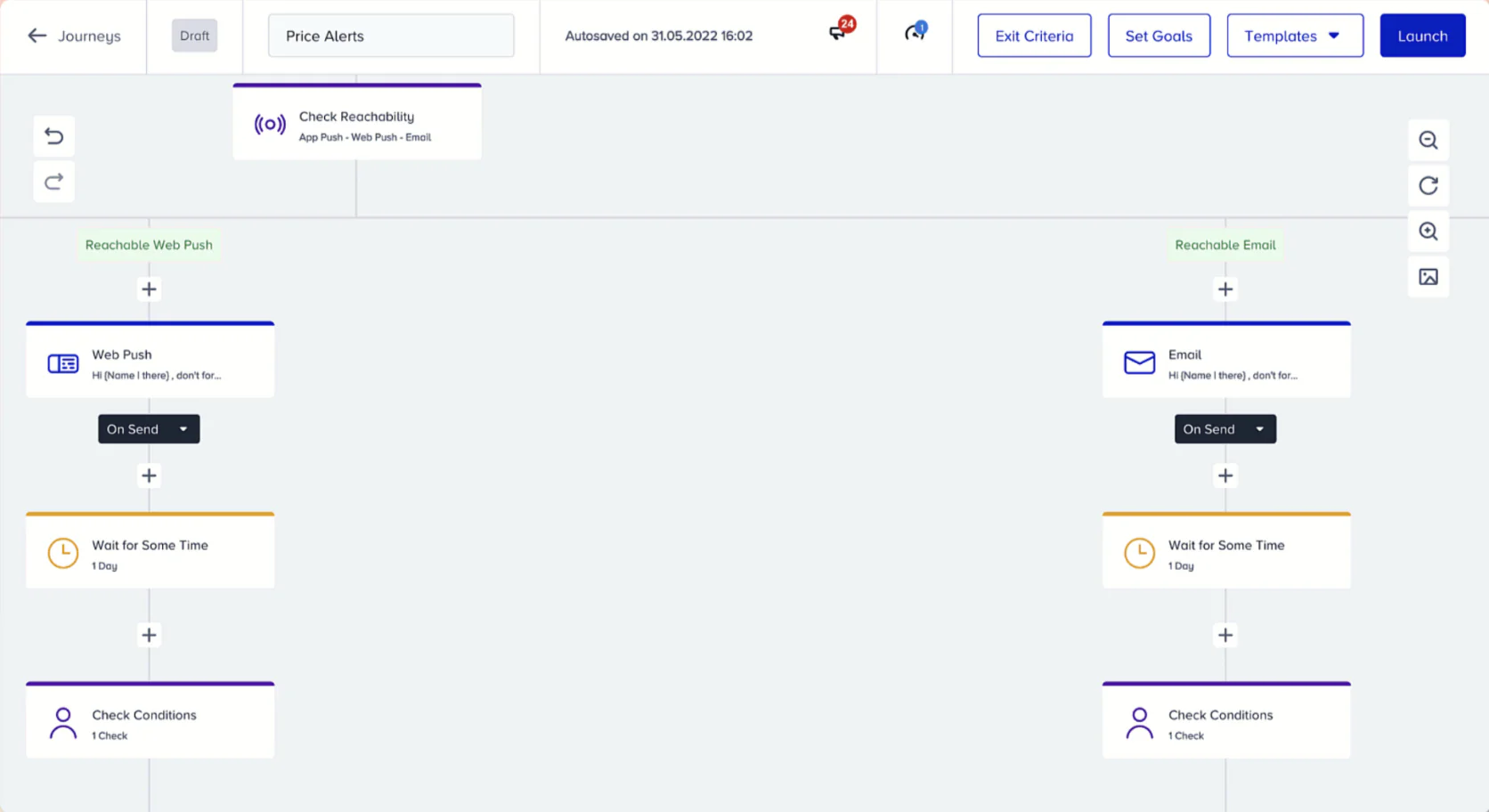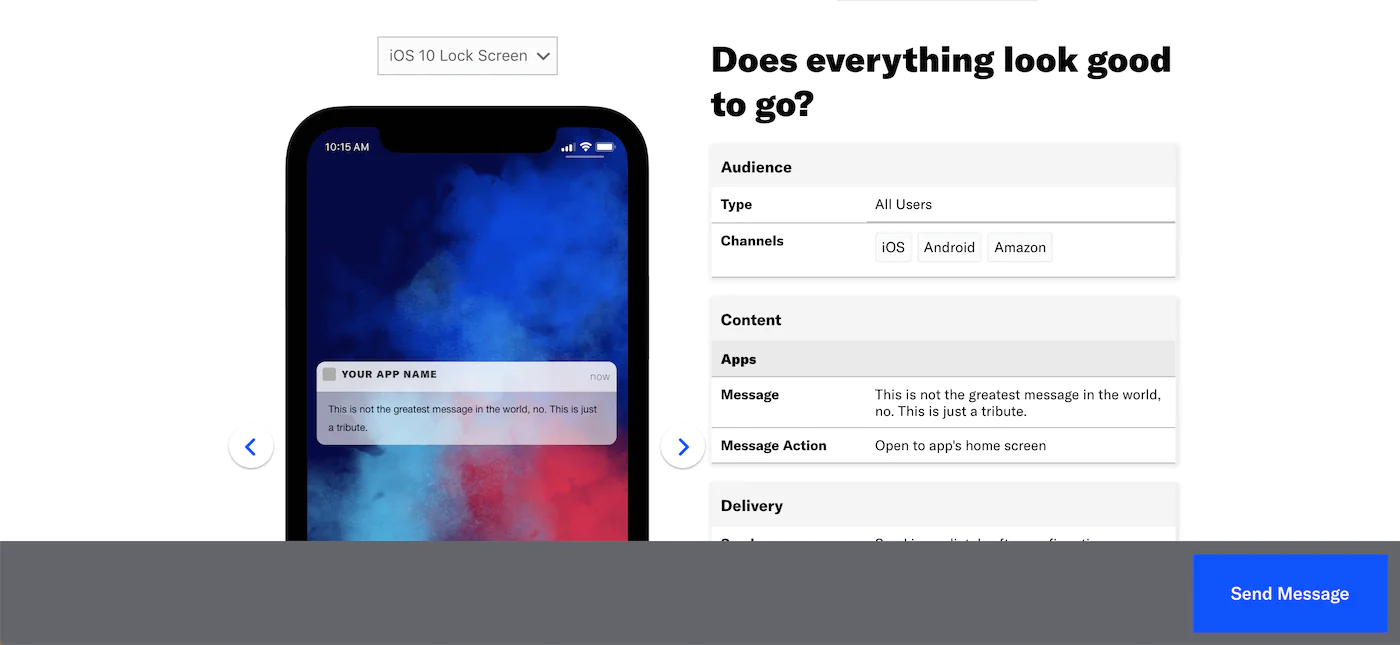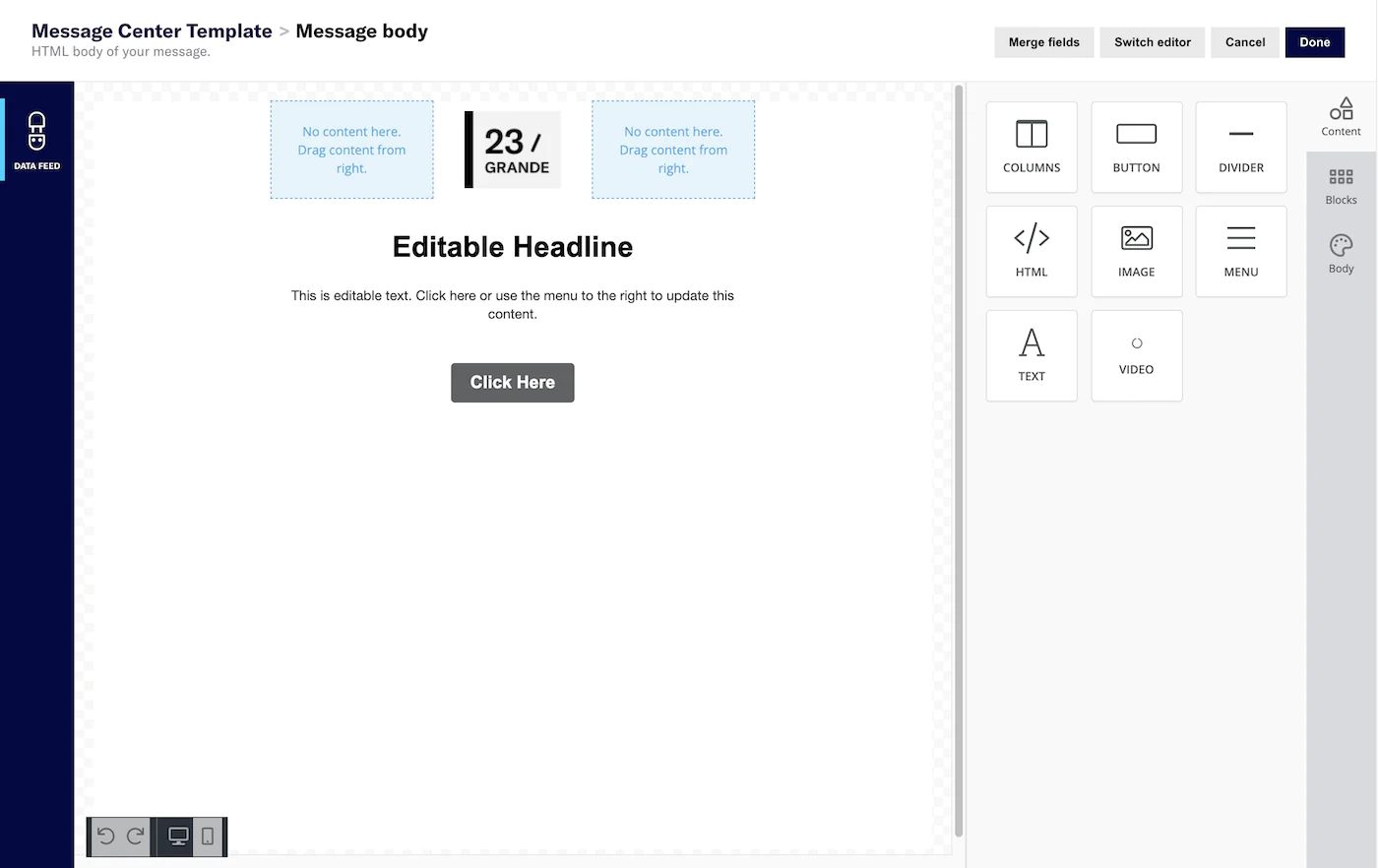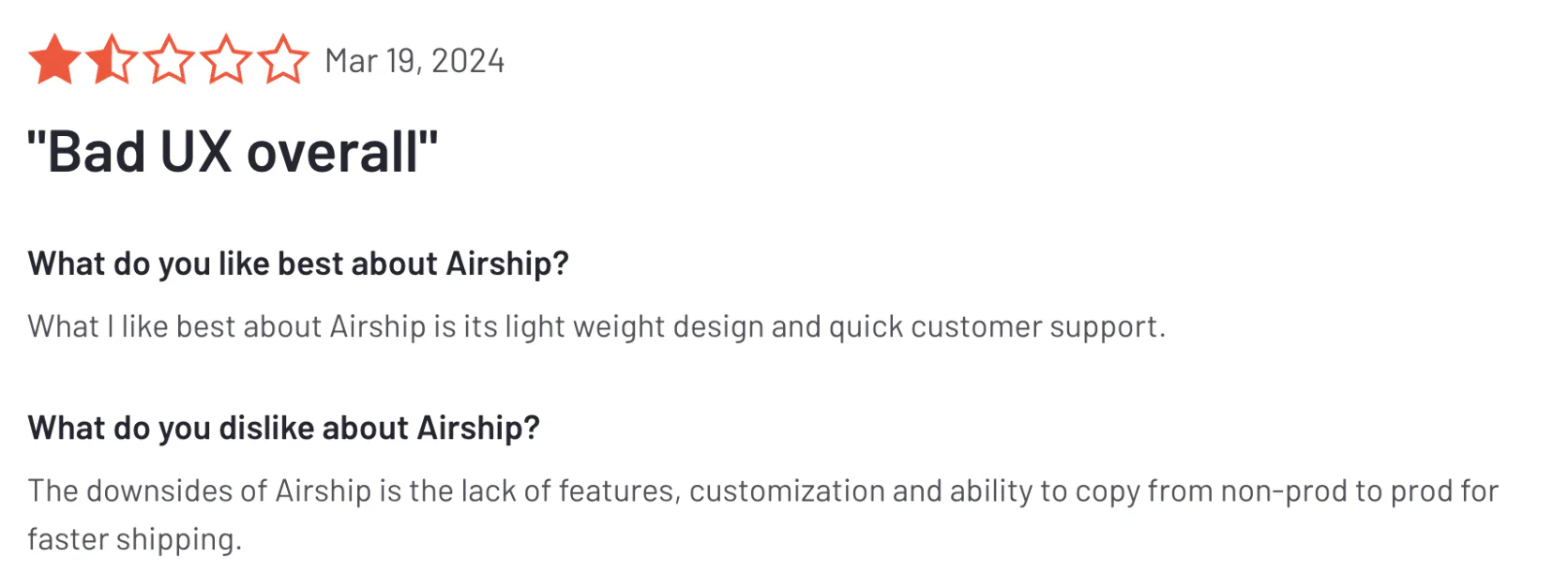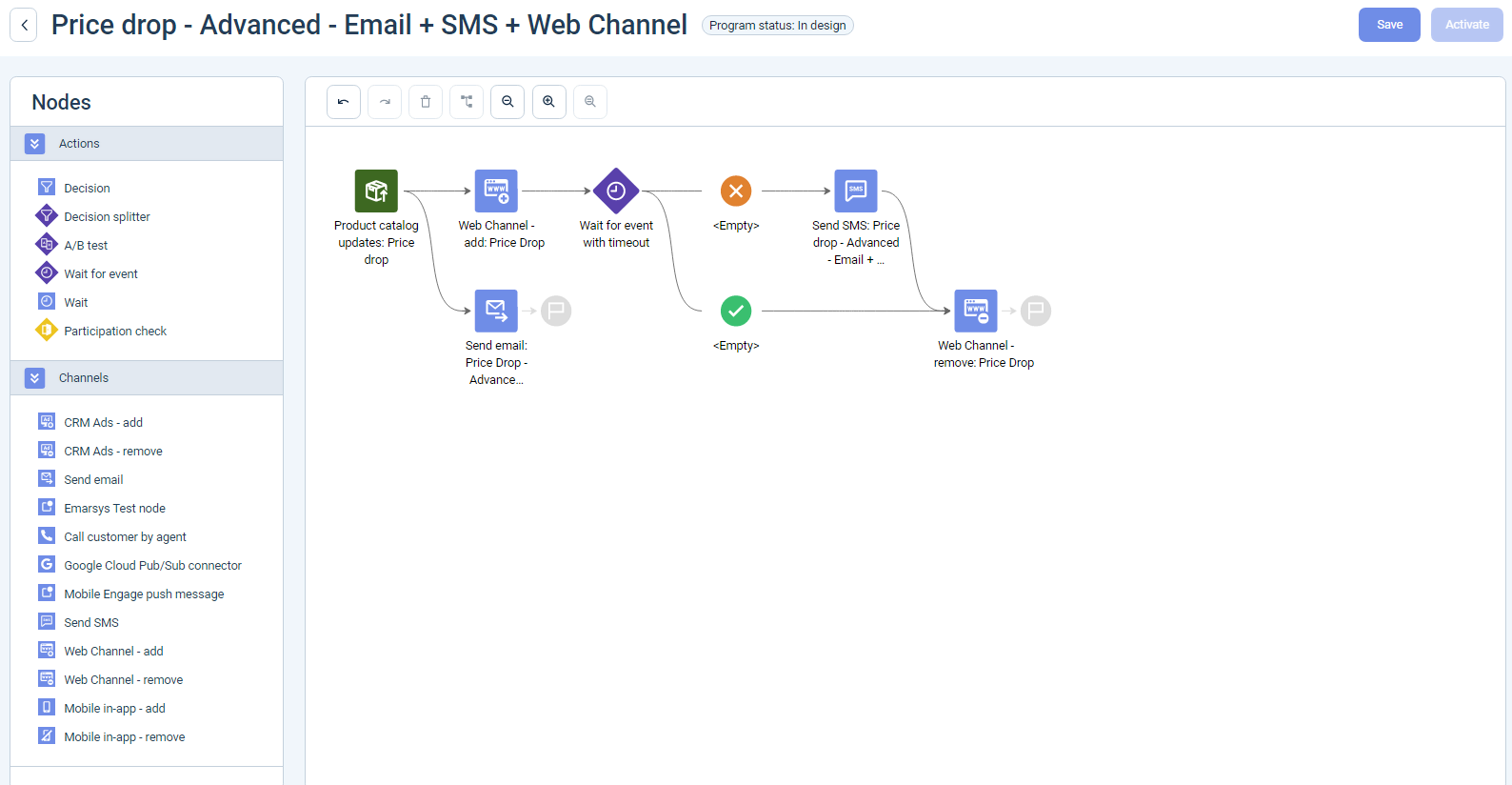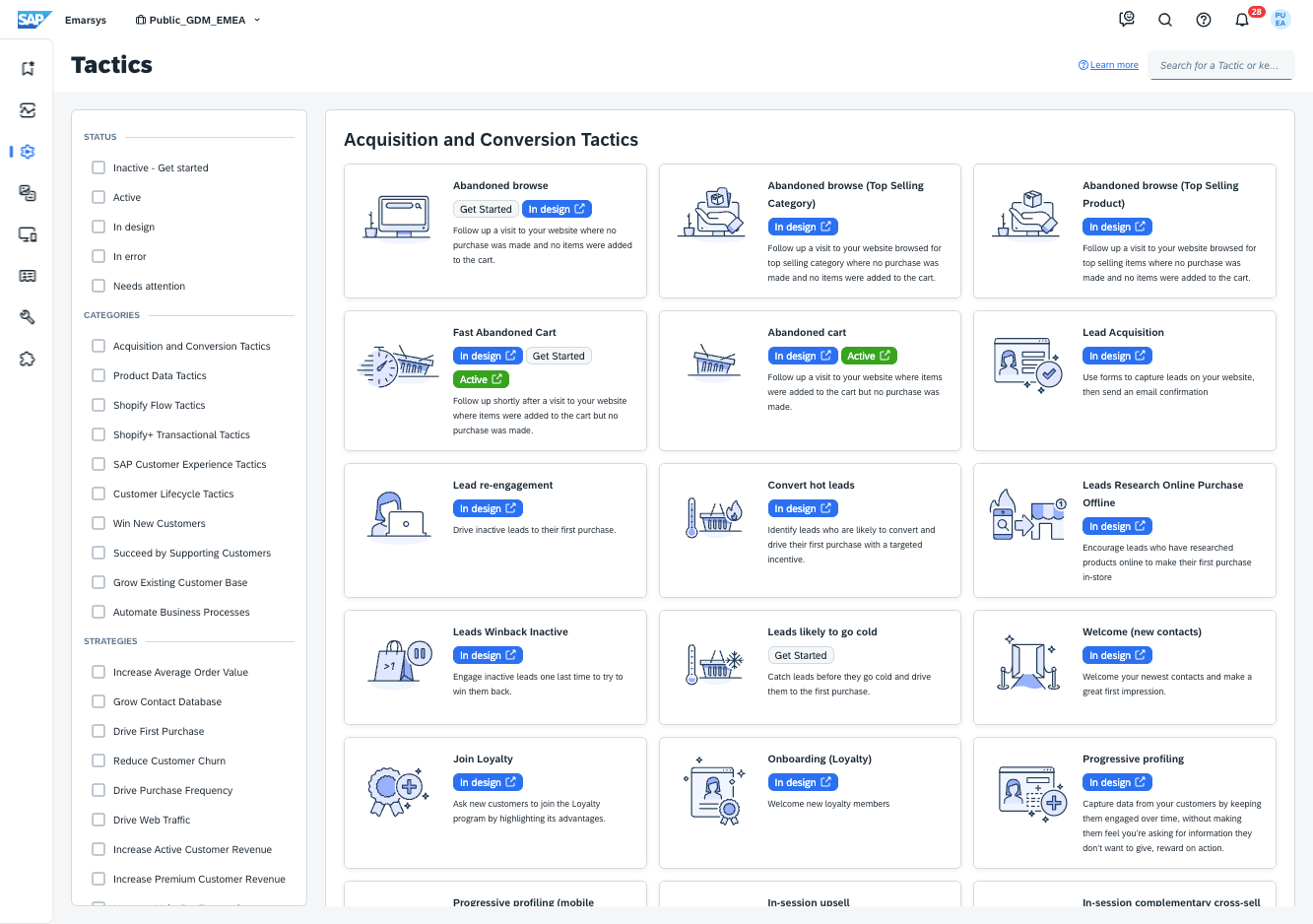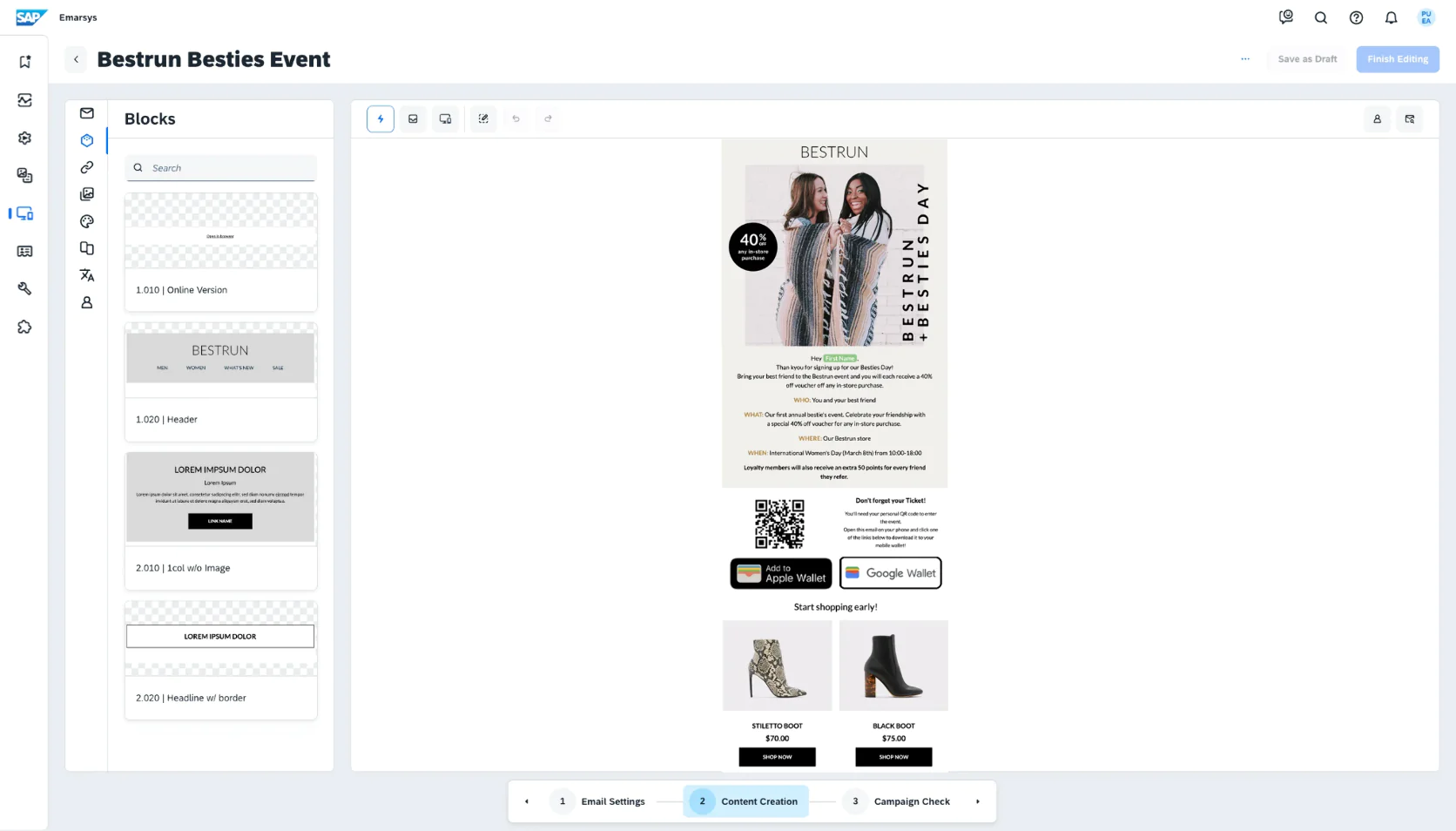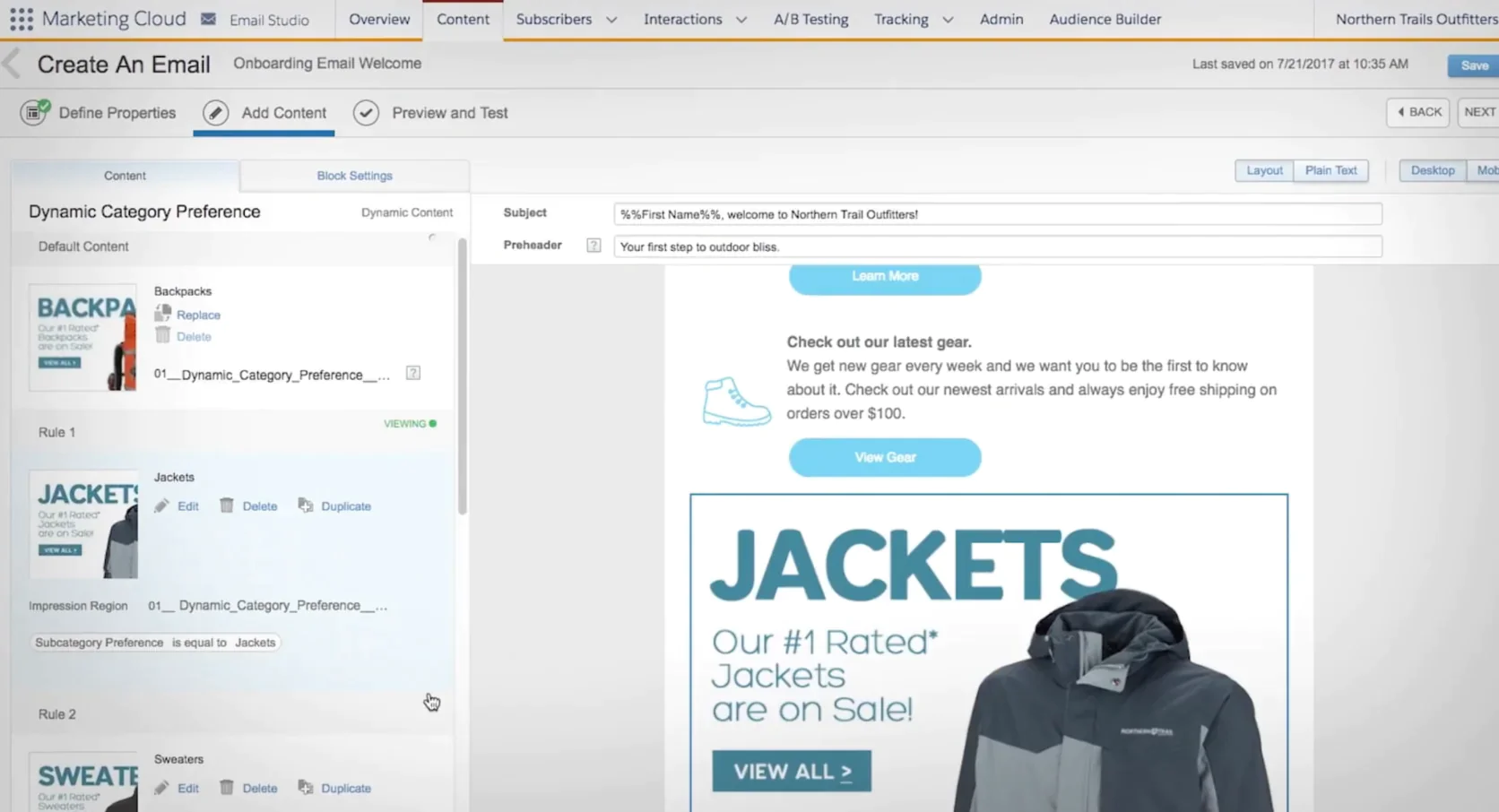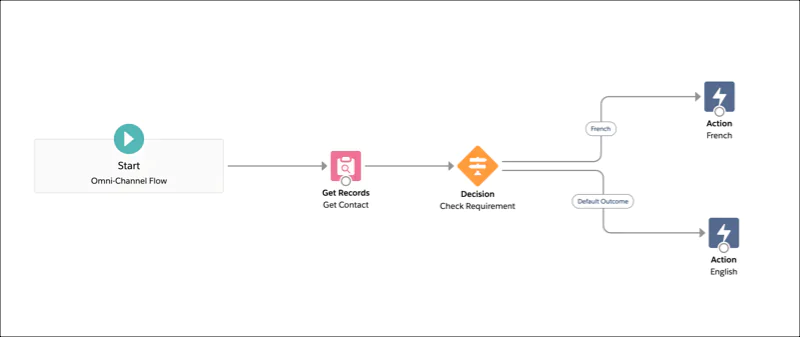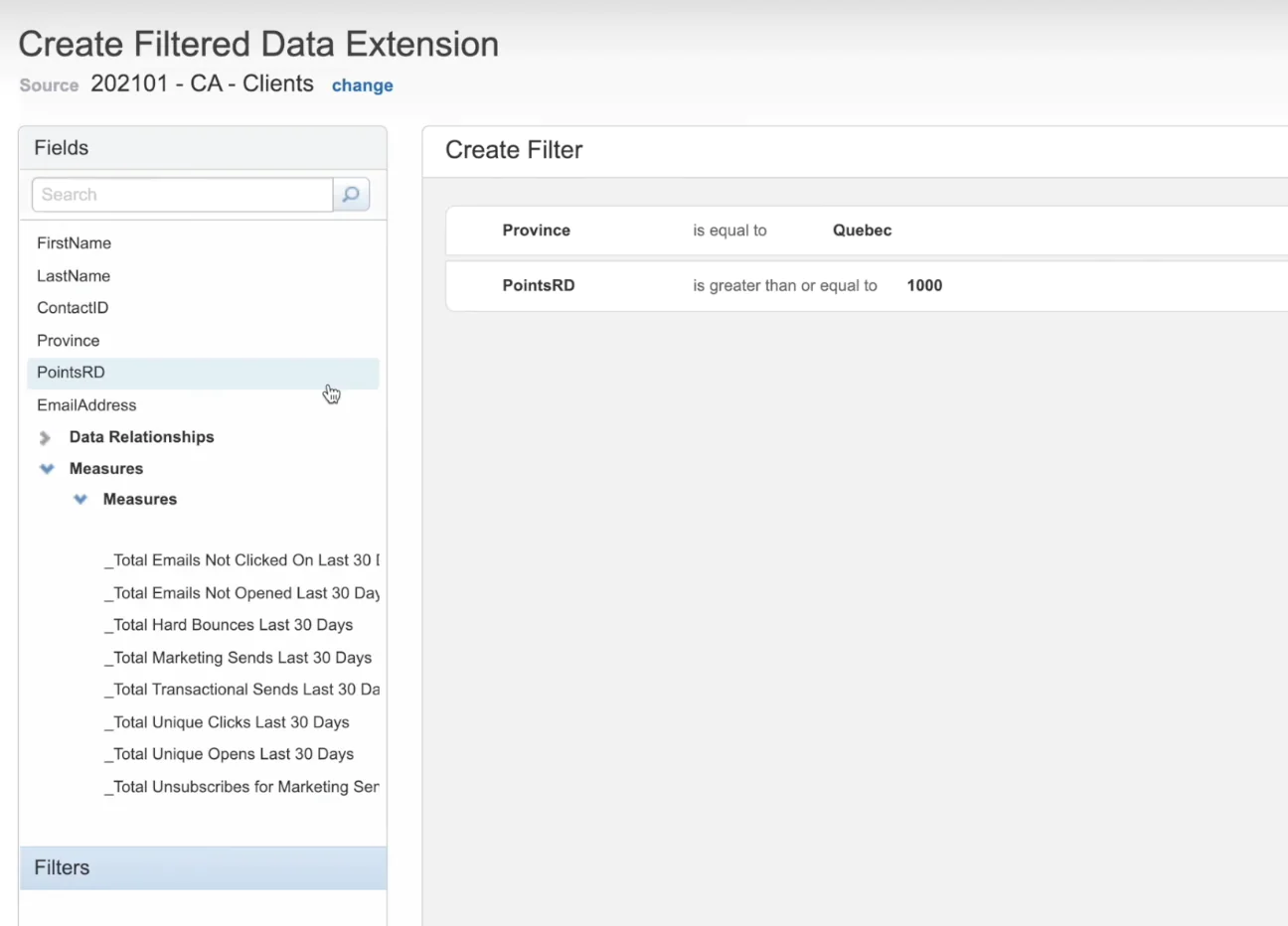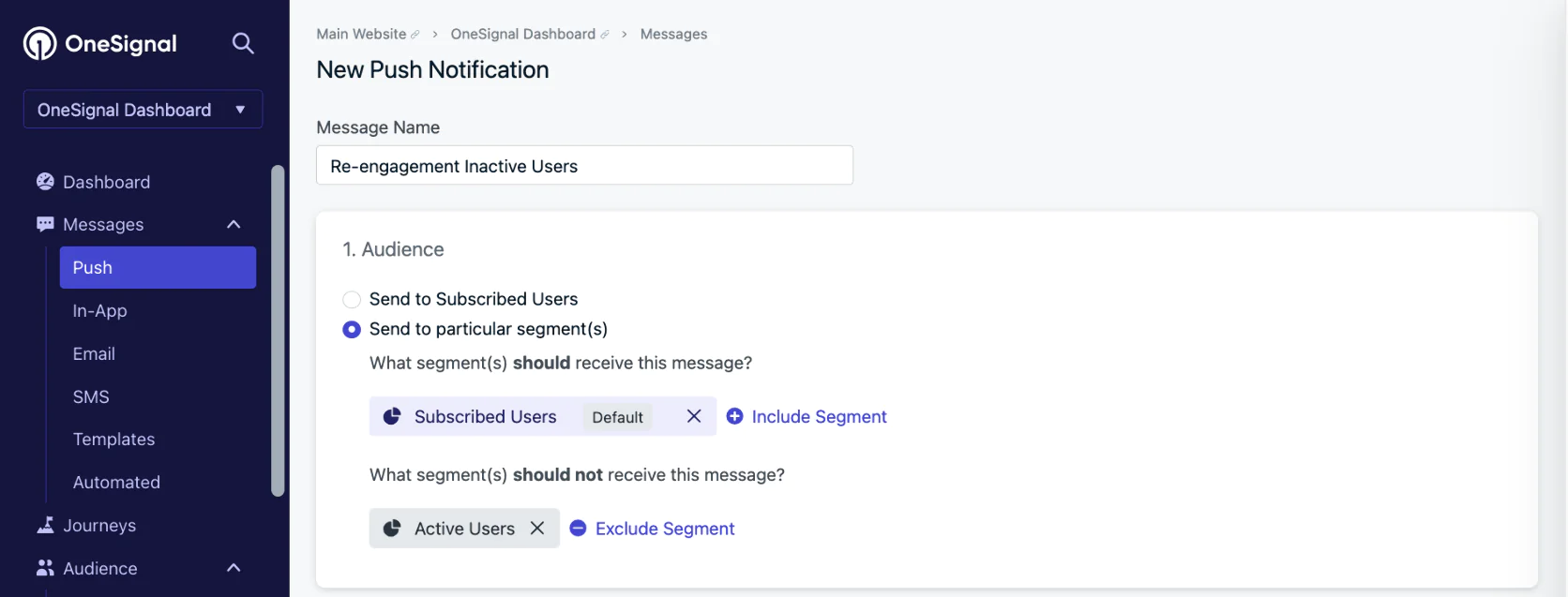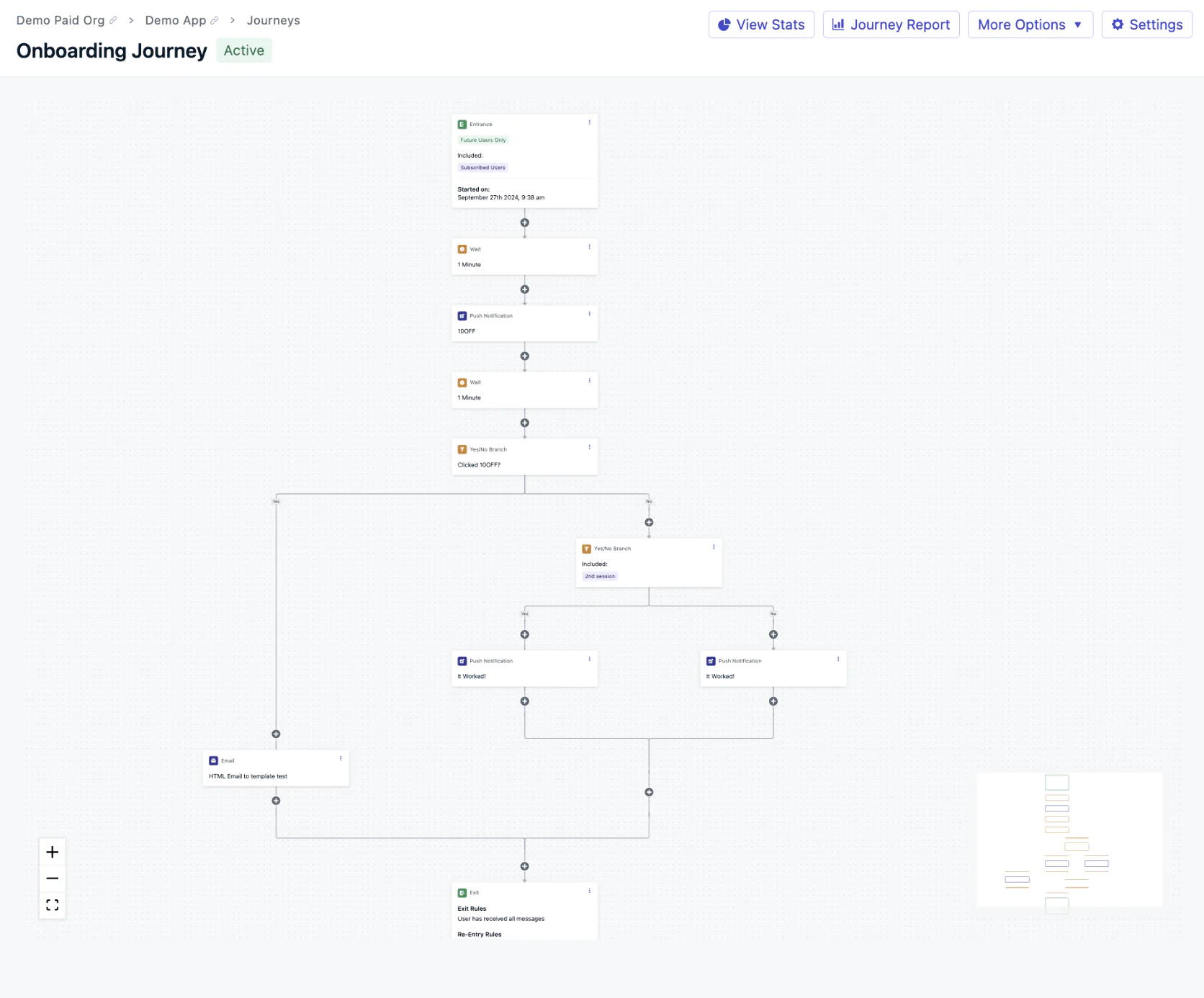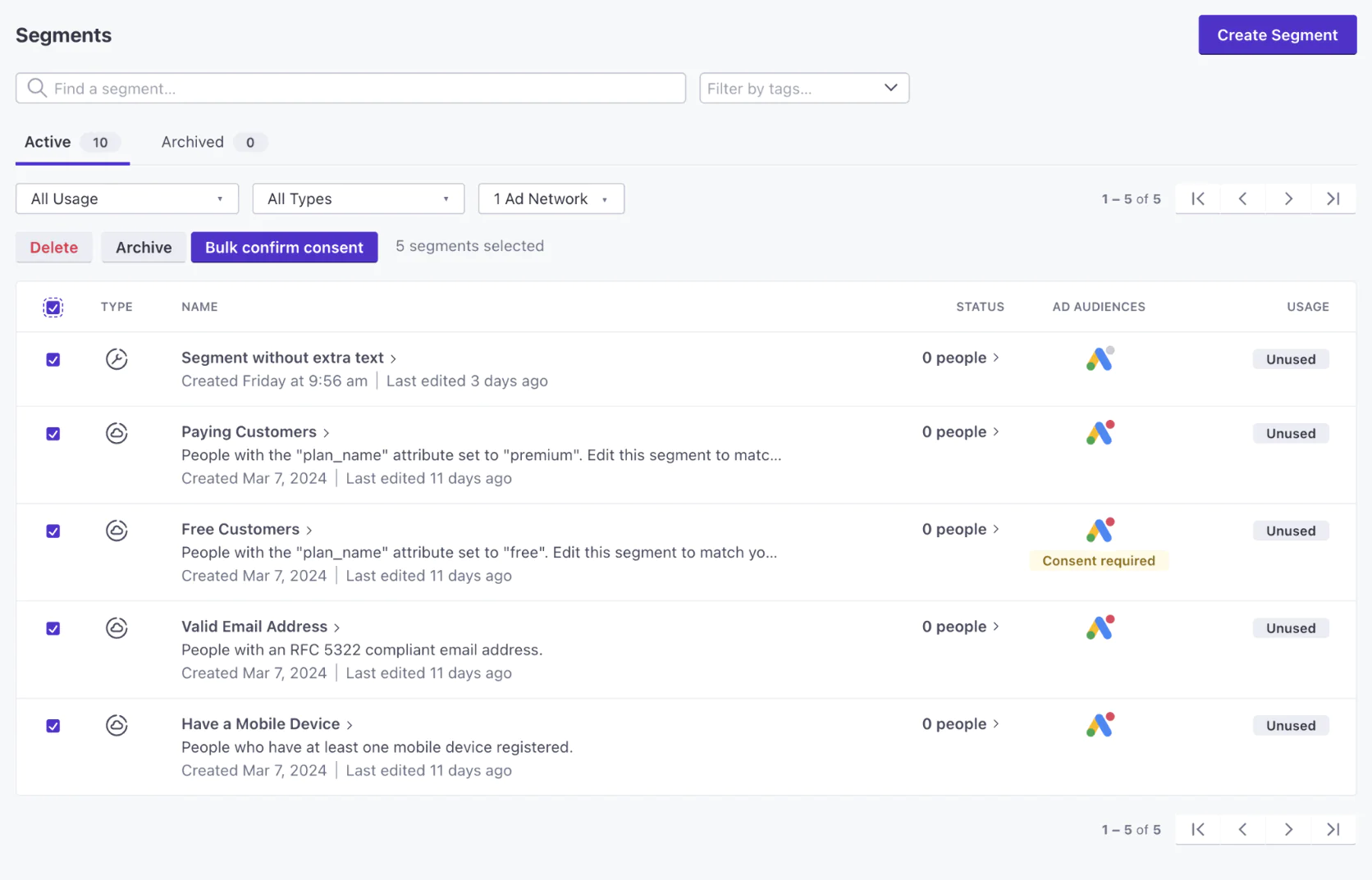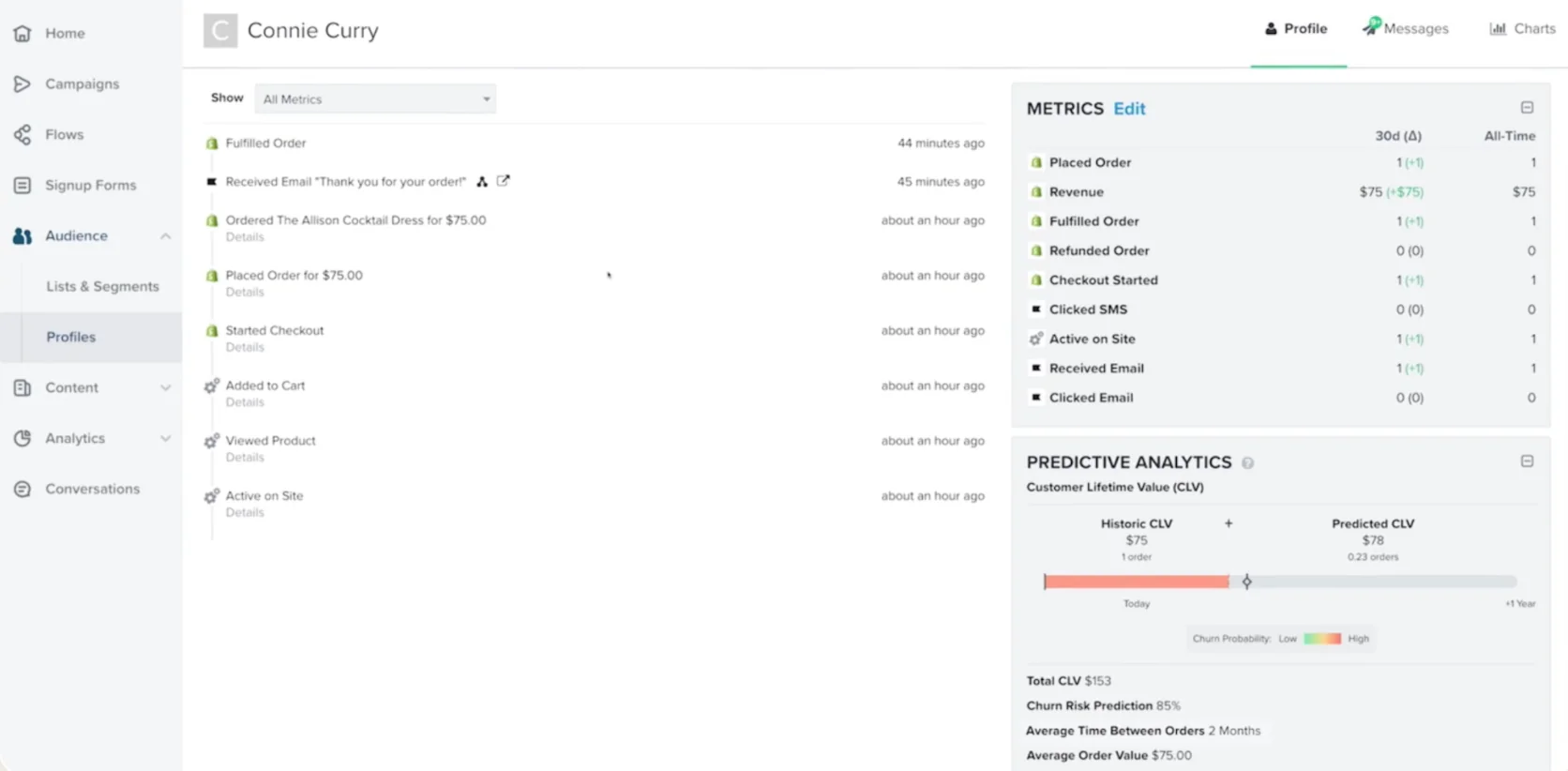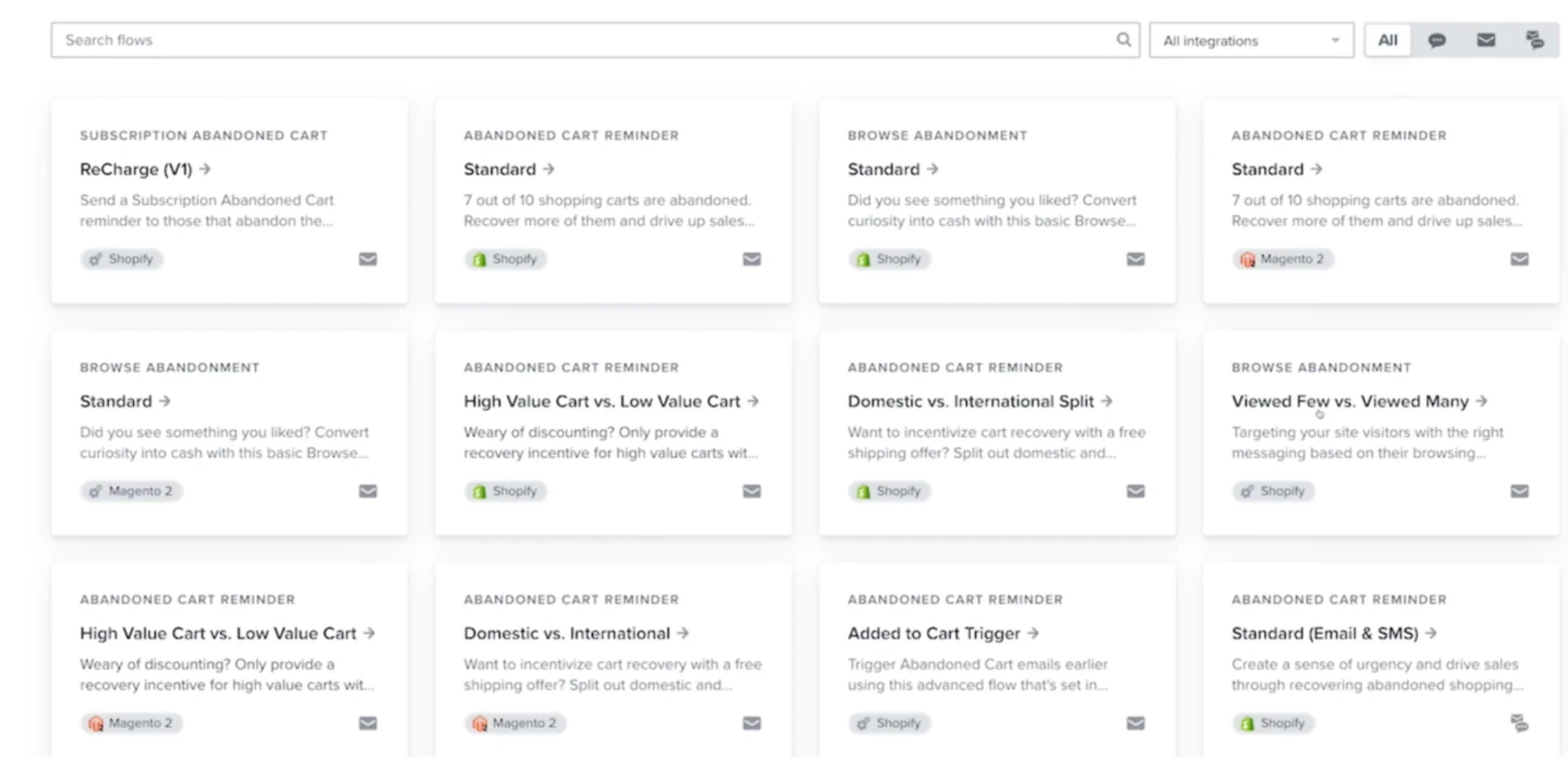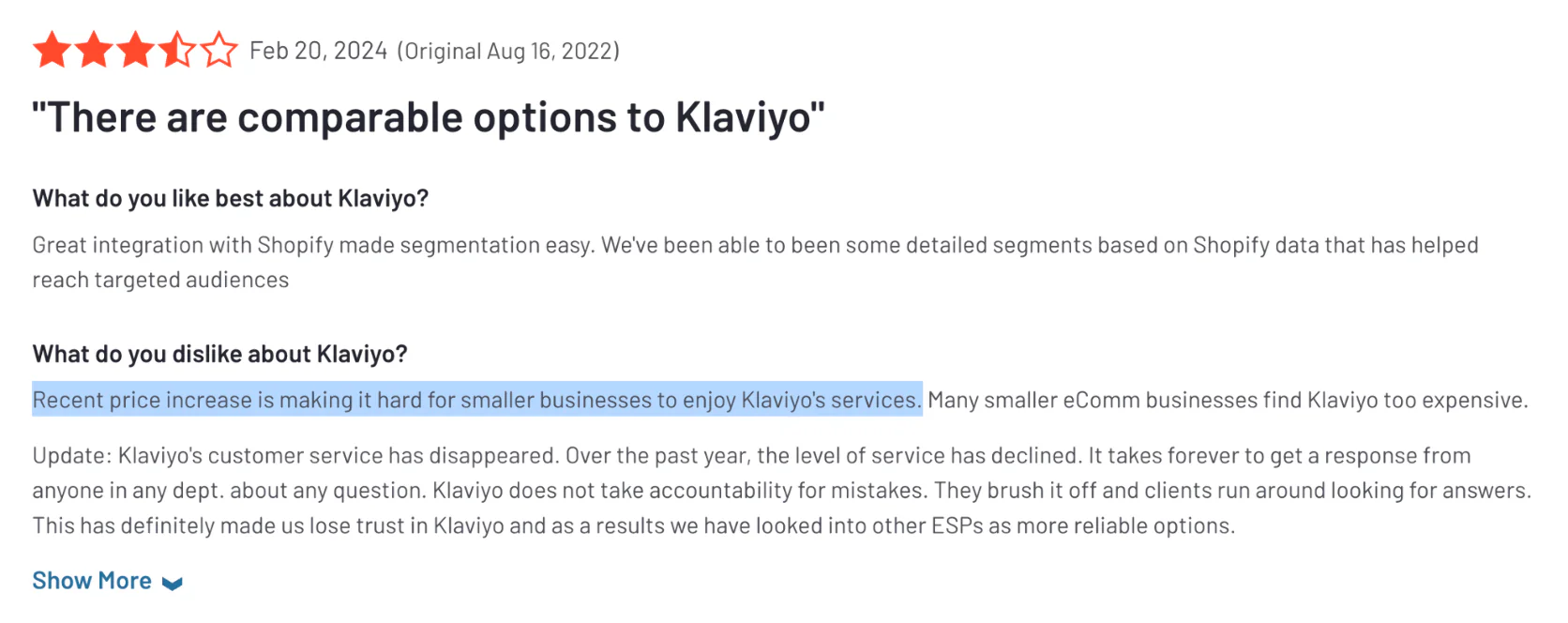12 Best CleverTap Alternatives for 2025: Smarter Omnichannel Engagement
Managing customer engagement across mobile apps, websites, and messaging channels can feel like juggling torches. One misstep—a delayed notification or impersonal blast—and you risk losing hard-won customers. The tools meant to help, like CleverTap, sometimes come with trade-offs. Some are clunky or siloed; others don’t scale with growth. If you’re a marketing leader at an e-commerce or retail brand, you might be wondering if there’s something better.
That’s why we’re breaking down 12 CleverTap alternatives for 2025.
CleverTap is a customer engagement platform that combines audience analytics, cross-channel messaging, and product A/B testing for personalized customer experiences. In other words, it’s an all-in-one solution for analyzing user behavior and engaging users across mobile and web. Marketers use CleverTap to create targeted campaigns at scale, using its insights to decide the best message for each segment.
What makes CleverTap notable is its focus on mobile app engagement. It builds rich user profiles with demographics and usage history, so you can understand how people navigate your app or site. CleverTap’s analytics let teams compare customer behaviors and funnel journeys to find opportunities, then trigger campaigns accordingly.
Let’s break down CleverTap’s core capabilities:
Analytics and Segmentation
At its core, CleverTap offers a powerful analytics engine and customer data platform. It tracks users’ actions in real time (app launches, purchases, etc.) and builds 360° user profiles including demographics and past behavior. Marketers can define segments based on these attributes—for example, “high-value shoppers who haven’t opened the app in 7 days”—and target them with tailored messages. Built-in funnel analysis and cohort reports help identify drop-off points or retention rates over time, informing how you segment and engage different customer groups.
CleverTap’s funnel dashboard
CleverTap also provides automated user segmentation using event criteria. For instance, users can automatically move into a “Cart Abandoners” segment if they add to cart but don’t purchase, triggering follow-up campaigns. This saves manual work and ensures your campaigns always hit the right audience.
Once you have your segments, CleverTap enables omnichannel engagement through a unified campaign builder. You can reach users via in-app notifications, mobile push, SMS, email, web push, and even channels like WhatsApp and voice calls—all from one platform. The journey orchestration interface lets you design sequences (e.g. send a push, then an email if no response) without code.
A marketer can, for example, set up a journey where a user who doesn’t open a promotional email within 24 hours gets an SMS reminder, and then an in-app message the next time they open the app. CleverTap ensures these messages stay coordinated so customers get a cohesive experience rather than a bombardment. The ability to combine channels (mobile and email and web) is key for brands that want consistent messaging everywhere.
Crucially, CleverTap’s messaging is trigger-based and personalized. Campaigns can start from user actions or lifecycle stages—first app install, cart abandonment, reaching a loyalty tier, etc.—and insert personalization tokens (like user name, product browsed) in the content. While its messaging templates are straightforward (not the fanciest email editor on the market), they cover the basics to get messages out on each channel.
AI Personalization and Testing
To optimize engagement, CleverTap has invested in AI and automation. Its Clever AI module analyzes user behavior patterns to predict outcomes like churn risk or conversion likelihood. These predictive scores help marketers target users who are likely to drop off with win-back campaigns, or conversely, identify high-intent users for upsells. For example, CleverTap can flag a segment of users with a high churn probability so you can send them a special retention offer.
Creating an email with Clever.AI’s recommendations
The platform also supports A/B testing and experimentation. You can create multiple variants of a message or app experience and let CleverTap automatically divide users to test which performs better. This is great for optimizing send times, subject lines, or even in-app UI changes. Results feed back into the analytics so you can iterate.
CleverTap’s personalization extends to product recommendations and targeting based on real-time behaviors. It can, for instance, send a push notification with a tailored product suggestion if a user views certain items repeatedly. And while CleverTap’s content personalization isn’t as deep as some specialized tools, it covers the basics for one-to-one messaging.
In summary, CleverTap offers a bit of everything: data analytics, multichannel campaign delivery, and AI-driven optimization. It’s especially strong for mobile-centric businesses that need to engage app users with timely, relevant messages.
However, no platform is perfect. There are a few areas where CleverTap might not meet your needs, especially as your business grows.
Pain Points with CleverTap
Even if CleverTap checks many boxes, you might run into some limitations in practice. Here are a few common pain points users cite:
Cost and Pricing Uncertainty
CleverTap’s pricing isn’t posted publicly—they have tiered plans but require contacting sales for quotes. For small apps, they do advertise an entry-level plan (around $75/month for up to 5,000 MAUs). This makes CleverTap accessible to startups initially. But costs can climb quickly as your user base grows. Higher tiers (“Advanced” or “Enterprise”) are custom-priced and can become quite expensive at scale.
In short, the lack of transparent pricing and potential for rising costs may leave teams guessing about the true budget impact. If you need a free plan or predictable flat pricing, CleverTap might disappoint. (There’s no free tier beyond a limited trial.) Budget-conscious teams often start exploring alternatives once their CleverTap bill balloons with user growth.
CleverTap packs a lot of features, which can make it complex for new users. Marketers report that the UI and terminology take some getting used to. The dashboard isn’t the most modern or intuitive, and setting up certain campaigns or integrations may require more technical help than expected.
For example, understanding CleverTap’s event taxonomy or advanced segmentation can be challenging at first. While they provide documentation and a user guide, it can still be confusing. Smaller teams without dedicated marketing ops or developer support might struggle to unlock the full potential of the platform. In contrast, some alternatives prioritize a more user-friendly, drag-and-drop approach out of the box.
Another related issue is that CleverTap’s extensive features can feel a bit too much if you only need basics. It’s powerful, but if you just want simple campaigns, the complexity can be overkill.
Data and Reporting Limitations
Having reliable, real-time data is crucial for engagement. Here CleverTap has received criticism for laggy analytics. Users have reported that the analytics dashboards can be glitchy or require manual refreshes to update. In fact, CleverTap doesn’t show data truly in real time—you might have to reload the page to get the latest metrics, which isn’t ideal when you’re monitoring fast-moving campaigns.
Additionally, some users mention occasional delays or slowness, especially when a lot of data or integrations are in play. If you’re running complex multi-channel efforts, waiting on the system or doubting the accuracy of reports (“Did that push actually go out to everyone?”) can be frustrating. Trust in the data is paramount, and any hiccups give an excuse to consider other platforms.
Finally, while CleverTap provides many analytics, some find that drilling down into custom reports or attribution isn’t as robust as they’d like. You might end up exporting data to external BI tools for deeper analysis—which partly defeats the purpose of an all-in-one platform.
Why (or When) to Consider Alternatives
CleverTap is a solid starting point for businesses, particularly those building out their first mobile marketing strategy. If you’re mainly focused on basic push notifications and simple campaigns, it can cover those needs. However, as brands mature and focus on creating truly connected, personalized customer journeys, flexibility and scalability become non-negotiable.
You might consider switching when you encounter one (or more) of these situations:
You’ve outgrown the basics. If your team is bumping against CleverTap’s limits—whether it’s needing more sophisticated loyalty features, finer segmentation, or just an easier workflow—it’s a sign to explore other options.
Costs are ramping up. When that monthly quote starts to bite, alternatives that offer more value or predictable pricing look attractive. There are platforms that include features (like advanced personalization or built-in loyalty) at a lower overall cost than a high-tier CleverTap plan.
Need for better integration. Perhaps you want a unified solution that covers web personalization or loyalty without a patchwork of add-ons. Or you require a platform that plays nicer with your existing data warehouse and tools. Some alternatives emphasize an open ecosystem or broader feature set.
In short, CleverTap can take you far, but it isn’t the final destination for every brand. The good news is you have plenty of choices. Let’s take a look at the top alternatives and what each brings to the table.
The Alternatives at a Glance
With that in mind, here’s a quick comparison of 12 popular alternatives to CleverTap in 2025:
Maestra
Full-funnel marketing for ambitious e-commerce brands
• Real-time CDP for unified customer data
• Hyper-personalized omnichannel flows
• Built-in loyalty and promotions engine
• Real-time site and product personalization
• Dedicated Customer Success Manager
From $2,990/month
Braze
Enterprise mobile engagement at scale
• Cross-channel campaigns (push, email, SMS, in-app, more)
• Visual journey builder (Canvas) for automation
• Real-time event streaming & segmentation
• Strong developer APIs and integrations
• “Sage AI” for predictive personalization
Custom pricing (often $60k+ per year)
MoEngage
Insights-led engagement for growing brands
• Advanced analytics with funnels & cohorts
• Multi-channel messaging (mobile, web, email, SMS)
• AI-powered recommendations & predictions
• Push amplification for better delivery
• On-site messaging and personalization
From ~$750/month (25k users); enterprise custom
WebEngage
Customer retention for emerging markets (APAC/India)
• Full-stack engagement: CDP + campaign manager + personalization
• Journey designer for cross-channel workflows
• Strong focus on SMS, mobile push, web push
• Localization and multi-language support
• Industry-specific solutions (e.g. fintech, e-commerce)
Custom pricing (starter plans ~$199/month)
Iterable
Cross-channel marketing automation for large B2C teams
• Easy-to-use interface with drag-and-drop workflow builder
• Multi-channel: email, SMS, push, in-app, direct mail
• Advanced segmentation & dynamic lists
• AI optimization for send time & channel
• Catalog-based personalization (recommended products)
Custom pricing (enterprise-level)
Insider
AI-driven personalization for retail & e-commerce
• AI-powered product recommendations and content
• Personalized web experiences (pop-ups, banners, etc.)
• Unified messaging across web, app, email, WhatsApp, SMS
• Customer journey orchestration with pre-built scenarios
• Conversion rate optimization tools (A/B testing, segmentation)
Custom pricing (basic ~$4,800/mo for 100k users)
Airship
Mobile-first messaging for enterprise apps
• Best-in-class push notification delivery and targeting
• In-app messaging and mobile wallet passes
• Support for email, SMS, and web notifications
• Robust APIs and developer tools (formerly Urban Airship)
• Journey automation focused on app user onboarding and retention
Custom pricing (enterprise quotes)
SAP Emarsys
Omnichannel marketing cloud for retailers
• Automated lifecycle campaigns with triggers
• AI-driven segmentation and product recommendations
• Email, SMS, push, and ads integration out-of-the-box
• Revenue attribution and analytics dashboard (ROI focus)
• Deep e-commerce platform integrations (SAP, Shopify, Magento)
Custom pricing (enterprise SaaS)
Salesforce Marketing Cloud (SFMC)
Enterprise marketing suite with CRM integration
• Modules for Email, Mobile, Social, Ads—unified via Journey Builder
• 360° customer view tied to Salesforce CRM data
• Powerful personalization and content tools (Content Builder, Einstein AI)
• Extensive ecosystem of add-ons and integrations
• Trusted platform for large-scale campaigns and loyalty programs
Custom pricing (high-end; often as costly as Braze)
OneSignal
Developer-friendly push notifications (plus email/SMS) for SMBs
• Generous Free plan (unlimited mobile push, up to 10k web subscribers)
• Easy SDK integration for mobile and web push
• Visual Journeys for simple automation flows
• Supports email, SMS, in-app messaging in one platform
• Affordable paid plans (Growth from $9/mo) for scaling usage
Free plan; paid $9–$999/month (self-serve tiers); enterprise custom
Customer.io
Flexible messaging automation for tech-savvy teams
• Highly customizable workflows with liquid scripting
• Multi-channel: email, SMS, push, Slack, and webhooks
• Real-time event tracking and customer profiles
• Option to self-host some components (for data-sensitive orgs)
• New Data & Messaging package with included CDP
Free tier (up to ~1,000 profiles via trial); paid from $150/month for ~12k profiles
Klaviyo
E-commerce brands focused on Email & SMS marketing
• Pre-built integrations with Shopify, BigCommerce, WooCommerce, etc.
• Powerful email and SMS automation flows (abandon cart, win-back, etc.)
• Embedded CDP for consolidating customer data
• Personalized product recommendations in emails
• Metrics tailored to e-commerce (CLV, repeat purchase rate)
Free tier (up to 250 contacts); paid from $20/month (for 251+ contacts)
Best CleverTap alternative for comprehensive e-commerce marketing
Maestra is an all-in-one omnichannel marketing platform built for e-commerce brands ready to leave the patchwork approach behind. With omnichannel automation flows, advanced real-time segmentation, in-session personalization, and even a built-in loyalty engine, Maestra doesn’t just help you keep up—it helps you lead. If CleverTap is a toolbox, Maestra is the fully equipped workshop.
Maestra’s flow example: abandoned card flow with emails, mobile and web pushes, pop-ups, paid ads and loyalty points
Real-time CDP and Segmentation: Maestra includes a real-time Customer Data Platform that unifies shopper data across online and offline touchpoints. It lets you segment with extreme granularity—down to individual page views or SKU interactions—and these segments update instantly as behavior changes. (No more waiting or manual list uploads.)
Maestra: user segmentation
Omnichannel Campaigns: Through Maestra’s drag-and-drop Flow Builder, you can orchestrate journeys across email, SMS, web pop-ups, push notifications, and even ads. For example, create a flow that sends an email, then a push, then shows a personalized on-site banner—all based on real-time behavior. It’s truly one-stop; no external tool needed for any channel.
Built-in Loyalty & Referrals: Unlike CleverTap (which would require a separate loyalty system), Maestra has native loyalty program management. You can reward points, tier VIP levels, and even trigger flows based on loyalty status. This ties directly into campaigns—say, sending double-point offers via SMS to Gold tier members automatically.
Maestra’s loyalty builder
Promotions Engine: Another unique perk—Maestra allows you to generate and distribute promo codes and discounts targeted to specific segments. You can set these to auto-apply in messages and even limit redemption (e.g. first 100 users). Great for flash sales or win-back incentives without manual code management.
Personalization Everywhere: Maestra offers real-time website personalization and product recommendations out of the box. It can dynamically change content on your site for each user (e.g. show different homepage banners based on past browsing) and include those same product recos in emails or push messages. It’s like having a personalization engine baked in.
Dedicated Support: Every Maestra client gets a dedicated Customer Success Manager. This is more than just an onboarding call—your CSM helps design your strategy, sets up custom flows, and even assists with migrations and integrations. It’s like getting an extension of your team included in the package.
Maestra essentially rolls up the capabilities of CleverTap plus a loyalty platform, plus a personalization tool, plus robust support—all into one solution. This comprehensive approach particularly benefits mid-market and enterprise e-commerce brands that want to consolidate their stack.
Maestra’s biggest strength? Making every customer interaction feel personal. It’s not about blasting messages—it’s about precision. Users praise Maestra’s hyper-focused segmentation and real-time triggers that ensure communications hit the mark. For example, you can set up product triggers like “low stock in your size” or “price drop on an item you viewed” and automatically send alerts at just the right moment. This level of timeliness is hard to replicate without a tightly integrated system. Maestra excels at it, helping brands create messages that don’t just resonate—they convert.
Another strength is ease of use despite breadth. Maestra manages to offer a wide feature set in a unified, relatively intuitive UI. The drag-and-drop flow builder and templated campaigns make it approachable, even though it’s doing heavy lifting behind the scenes. Marketers report that they can build sophisticated journeys without coding, whereas achieving similar in other tools might require multiple integrations or developer help.
Maestra’s visual email composer
The detailed touches shine too. For instance, Maestra’s dynamic email composer ensures your emails are automatically optimized (images compressed, no Gmail clipping, etc.). And the platform updates segments in real time, so if a customer makes a purchase, they exit the “win-back” flow immediately—no delay.
When it comes to drawbacks, Maestra doesn’t give you much to gripe about. One consideration is fit: its pricing and full-service approach are geared towards mid-market and enterprise brands, not small startups. Pricing starts at $2,990 per month—which, while fair for the value, is a jump from tools with entry-level plans. So, Maestra is not the cheapest option; it’s an investment (though one that consolidates several other tool costs).
Another potential gap is if you need niche features outside marketing—say, a platform that doubles as a helpdesk or a sales CRM. Maestra stays in its lane (marketing and engagement). This isn’t a weakness per se, but something to note if you were looking for a do-it-all business platform. For pure marketing needs, Maestra is comprehensive.
Lastly, because Maestra offers so much, fully implementing it might take some time (which the CSM will help with). Brands coming from a simpler tool might need to allocate effort to migrate data and set up new omnichannel strategies. The good news: with hands-on support, you’re not left alone in that process.
While both CleverTap and Maestra aim to be omnichannel engagement platforms, Maestra takes a more holistic approach. CleverTap covers mobile and messaging well, but still often relies on third-party add-ons for things like loyalty or advanced web personalization. Maestra eliminates that patchwork. Everything is built-in and designed to work seamlessly together—from the real-time CDP to the loyalty program to on-site personalization.
In practice, this means fewer data silos and a more unified customer journey. CleverTap might require you to integrate an external recommendation engine or manually import loyalty point data, whereas Maestra has those natively—so you can, for example, include loyalty point balances in an email without any custom dev work.
Maestra is also tailored for retail and e-commerce in a way CleverTap isn’t. CleverTap’s roots are in mobile app engagement broadly (they serve finance apps, streaming apps, etc.). Maestra is purpose-built for commerce: cart abandonment flows, product catalog syncing, back-in-stock alerts, RFM (recency/frequency/monetary) segmentation—it speaks the language of retailers. Brands selling products online will find Maestra covers use cases that might require more customization in CleverTap.
Additionally, service and support set them apart. CleverTap provides support documentation and account managers for enterprise clients, but Maestra’s dedicated CSM model is more high-touch. It feels like having a strategist on call, which can make a huge difference during onboarding and beyond. If your team could benefit from guidance (and an extra pair of hands), Maestra offers that out-of-the-box.
In short: CleverTap is a strong platform, especially for mobile-focused engagement, but Maestra is a more complete solution for brands that want to unify all marketing channels and loyalty in one place. It’s the difference between adding another tool versus leveling up your entire marketing stack.
Who Should Choose Maestra
Maestra is the go-to for e-commerce, retail, and DTC brands that want to drive revenue with personalized, data-driven marketing. If you’re running an online store (or multiple brands) and feel held back by fragmented tools or limited personalization, Maestra was built for you. It’s ideal for teams that value depth over breadth—you get a lot of capabilities, and you intend to use them to create sophisticated customer journeys.
Brands with ambitious growth goals (and the budget to invest in a premium platform) will see the best ROI. Also, if you appreciate having expert support to maximize a tool, Maestra’s CSM approach will be a breath of fresh air. On the flip side, if you’re a very small business or just dipping a toe into lifecycle marketing, Maestra might be more firepower (and cost) than you need at the moment—in that case, one of the lighter alternatives might suit until you graduate to Maestra’s level.
Best CleverTap alternative for enterprise cross-channel campaigns
Braze (formerly Appboy) is often considered the gold standard for enterprise customer engagement. It’s an AI-powered platform that helps large brands switch from running siloed campaigns to creating cohesive, orchestrated customer journeys. If you need a high-performance engine to manage messaging for tens of millions of users in real time, Braze has you covered.
In Braze, everything centers around its real-time data streaming and “Canvas” journey builder. It continuously ingests customer events (like a user browsing a product or completing a purchase) and lets you respond instantly with targeted messages. Braze builds comprehensive user profiles by collecting data from every touchpoint, much like CleverTap, but it particularly shines in scale and speed.
One of Braze’s biggest strengths is its cross-channel breadth combined with depth. It supports a wide array of channels: push notifications, in-app messages, email, SMS, webhooks, content cards (in-app content feeds), and more—all orchestrated in one Canvas flow. Each channel in Braze is fairly robust; for example, its email tool, while not as fancy as a dedicated ESP, is capable and supports AMP emails, etc. Few platforms do all channels this well under one roof.
Braze is also praised for its developer-friendly approach. It has strong APIs and an open approach to data. You can stream data in and out via webhooks and APIs, making it easier to integrate Braze with your data warehouse or other systems. For engineering teams that want tight control and custom logic, Braze is a top pick. Their documentation and support for developers are excellent.
Another strength: real-time personalization at scale. Braze’s personalization (via Connected Content and their Sage AI) can fetch external data at send-time, insert dynamic recommendations, and even use predictive models to tailor messages. For instance, you can pull in live inventory data into a push message (“Only 3 left in stock!”). This level of dynamic content generation is something many simpler tools can’t handle, especially not at Braze’s speed.
Creating a segment in Braze
However, all this power comes with trade-offs. Braze is known to have a steep learning curve for new users. The platform is complex; marketers often need training or even certification to use it effectively. Smaller teams without a dedicated Braze expert might feel overwhelmed configuring data feeds, Canvas flows, and custom events.
Another weakness is cost. Braze operates at an enterprise price point—there’s no free tier, and even modest use cases often start around $60k+ per year. Pricing is quote-based and can include add-on costs (e.g. for higher message volumes or premium support). This can put it out of reach for many mid-market companies.
Also, Braze, while powerful, doesn’t natively include some marketing features like loyalty programs or surveys—it focuses on messaging and data, so you’d integrate other tools for those needs. It’s not an all-in-one marketing suite; it’s more narrowly an engagement and messaging engine.
Braze and CleverTap target a similar space (omnichannel customer engagement), but Braze is generally seen as the more enterprise-grade solution. It excels in high-volume, real-time use cases—where milliseconds of delay matter and complex messaging logic is needed. CleverTap might be easier to get started with and possibly cheaper at small scales, but Braze often wins with larger organizations due to its scalability and mature feature set.
Unlike CleverTap, Braze does not have built-in A/B testing of app UI or product experiments (CleverTap has some of that), focusing more on communications.
Braze also tends to rely on partners or integrations for on-site personalization, whereas CleverTap added some web personalization out-of-the-box. So, if those specific features matter, CleverTap could have an edge. But for pure campaign orchestration and data agility, Braze is hard to beat.
Braze and Maestra both cover cross-channel messaging, but their philosophies differ.
Braze is like a highly customizable toolkit—extremely powerful if you invest the time and resources. Maestra leans toward an all-in-one solution with more out-of-the-box capabilities (loyalty, etc.) and hands-on guidance.
For an enterprise with a big tech team and unique requirements, Braze’s flexibility is attractive. For a marketing team that wants breadth (including loyalty, on-site personalization) and more guidance, Maestra might deliver more bang for the buck.
Large companies and fast-growing tech-savvy brands that require enterprise scalability and don’t mind the enterprise price.
If you have millions of users across multiple platforms and need to orchestrate complex campaigns (and perhaps you have developers or data engineers to help), Braze is an excellent choice. Industries like global retail, telecom, fintech, and media often use Braze to manage massive engagement programs.
Just be ready to invest in onboarding and perhaps dedicate an “owner” to the platform to fully leverage it.
Best CleverTap alternative for insights-led mobile engagement
MoEngage is another top player in the customer engagement arena, often mentioned in the same breath as CleverTap. In fact, MoEngage and CleverTap are direct competitors frequently compared side-by-side. Like CleverTap, MoEngage offers a blend of analytics and cross-channel campaign execution, branding itself as an “insights-led” engagement platform.
MoEngage’s platform enables personalized messaging across multiple channels—push notifications, in-app messages, email, SMS, web push—all coordinated from one dashboard. Its focus is on helping brands understand users through robust 360° analytics, then act on those insights with targeted campaigns. If CleverTap ever left you wanting slightly more analytical depth or a smoother interface, MoEngage aims to provide that.
One of MoEngage’s strengths is its analytics and AI capabilities. The platform provides detailed funnels, cohort analysis, and even predictive segments (similar to CleverTap’s). It can identify, for example, users likely to make a purchase in the next 7 days or those at risk of churning, using machine learning on behavioral data.
These insights are surfaced in a marketer-friendly way, guiding you on which segments to target for better ROI. MoEngage’s tagline of “insights-led” isn’t just fluff—users often praise the depth of analytics and how it informs campaign strategies.
MoEngage’s push notification click propensity
In terms of messaging, MoEngage covers all the core channels and has a particularly strong push notification delivery system. They have features like Push Amplification, which is designed to improve delivery rates on Android devices (by working around OEM restrictions)—a handy edge if mobile push is key for you. They also have an emphasis on “smart triggers” and automation, so you can set up multi-step flows reacting to user behavior in real time.
Usability is another area of relative strength. MoEngage’s UI is considered clean and intuitive for the amount of features it packs. Some find it a bit easier to navigate than CleverTap’s interface. There’s a drag-and-drop journey builder (Flows) that is comparable to others, and setting up campaigns is generally straightforward. For teams without heavy technical support, MoEngage can be a tad more approachable.
On the downside, MoEngage can become expensive as you scale (similar to CleverTap). While they do offer packaged plans—and even a Growth package around $750/month for ~25k users—large enterprises will end up on custom pricing. The cost tends to rise with monthly active users and messaging volume. It’s often more transparent than Braze or SFMC, but you’ll still need a sales conversation for big plans.
Another weakness is that MoEngage, like CleverTap, is primarily focused on the digital engagement side. It doesn’t natively include extras like a loyalty program module or advanced CRM capabilities. You might need integrations for those.
MoEngage’s App Marketplace
Additionally, some users note that while MoEngage’s analytics are strong, the reporting interface could be more flexible for custom reports. In many tools, exporting to CSV or using external BI might still be needed for very custom analysis.
In terms of support and community, MoEngage is growing. It may not have as large a community as Braze, but they do have active customer success teams, especially in regions like Asia and Europe where they have a strong presence. Global support is something to consider—MoEngage is headquartered in San Francisco with roots in India, and they cater well to APAC clients as well as the US.
MoEngage and CleverTap are more alike than different.
Both offer a full suite of engagement tools with a mobile-first design. If we draw distinctions, MoEngage might edge out in analytics UI polish, whereas CleverTap touts new innovations like TesseractDB for big data.
One notable difference: MoEngage has a self-serve option for smaller clients (and even a free trial), whereas CleverTap is more exclusively sales-driven at the higher end. MoEngage’s presence on the AWS Marketplace suggests a bit more transparency in entry pricing.
MoEngage is more directly comparable to CleverTap/Braze than to Maestra’s all-in-one ecom focus.
MoEngage doesn’t include loyalty or on-site personalization natively like Maestra does. So, a retail brand might still need additional software alongside MoEngage, whereas Maestra could cover more bases in one.
Maestra also provides a dedicated CSM; MoEngage typically will have an onboarding team but not necessarily a permanent CSM model.
Cost-wise, MoEngage could be lower than Maestra at small scale, but at enterprise scale, costs might converge.
Who Should Choose MoEngage
If you are a mobile-first business or a digital product company that values strong analytics and a unified engagement platform, MoEngage is a great choice. It’s popular among mobile app companies, fintech apps, media streaming services, and also many e-commerce players—especially in Asia and Europe—who want a capable CleverTap alternative. Mid-sized companies that feel Braze is too expensive or heavy often find MoEngage hits a “sweet spot” of powerful yet slightly more affordable.
In summary, MoEngage is a robust, marketer-friendly platform that brings CleverTap-like capabilities with a potentially smoother experience. It’s well-suited for teams that want to be data-driven in their engagement and are ready to build intelligent multi-channel campaigns without going to the top-tier (and cost) of an enterprise behemoth.
Best CleverTap alternative for customer retention in emerging markets
WebEngage is a full-stack customer engagement and retention platform that has made waves particularly in India, the Middle East, and other emerging markets. It offers a “CDP + omnichannel campaign manager + personalization engine” all in one, very much positioning itself as a one-stop solution for lifecycle marketing. If your goal is to boost customer retention and you operate in markets where localized support matters, WebEngage is worth a look.
WebEngage’s Journey Designer
Originally known for its on-site feedback and notification tools, WebEngage has evolved into a comprehensive retention operating system. It provides a Customer Data Platform to unify user data, Journey Designer to automate campaigns, and personalization capabilities for both web and app. Much like CleverTap and MoEngage, WebEngage lets you craft cross-channel customer journeys triggered by behavior or time.
A key strength of WebEngage is its breadth of channels and use cases with a focus on retention metrics. It supports push, email, SMS, in-app, web push, WhatsApp, Facebook/Google ads, and more. WebEngage particularly shines with web pop-ups, surveys, and feedback widgets, a nod to its origin—features that not all competitors have. This can be useful if you want to incorporate user feedback or on-site surveys into your engagement strategy (e.g., post-purchase feedback prompts).
WebEngage has built-in campaign ideas and industry templates. For example, e-commerce brands get ready-made flows for cart abandonment, browse abandonment, etc. This helps teams get started quickly.
The platform also supports dynamic segmentation and RFM analysis (recency, frequency, monetary)—useful for retention marketers to target best customers versus at-risk ones.
WebEngage’s cohort analysis
Another strength is WebEngage’s pricing flexibility. They actively cater to businesses in emerging markets with perhaps more accessible pricing for those regions (reports of starting around $199/month for basic plans). They even have a Startup Program that offers credits to early-stage companies.
On the flip side, WebEngage may not have the same ultra-polished UI as some competitors. It’s good and improving, but a bit less sleek in parts. Also, their newer CDP module, while useful, is not as battle-tested as dedicated CDPs—it covers basics but complex identity resolution might be limited.
Another weakness is that WebEngage’s brand recognition and community outside its core markets is still growing. So if you are in North America or Europe, you might find fewer experienced specialists or third-party resources for WebEngage compared to Braze or others. That said, their customer success team is known to be responsive and hands-on.
Feature-wise, WebEngage might lag slightly in cutting-edge AI features. It has personalization and some predictive segmentation, but perhaps not the level of AI-driven recommendations or predictive scores that CleverTap or Braze offer with their AI modules. They are more focused on practical, marketer-friendly tooling than on touting AI (at least as of now).
WebEngage offers a very similar value proposition to CleverTap—unified analytics, segmentation, and multi-channel campaigns.
One noticeable difference is WebEngage’s inclusion of on-site engagement tools (feedback, surveys) which CleverTap doesn’t have natively.
Also, WebEngage often comes in at a lower price for comparable usage, especially for mid-sized companies.
However, CleverTap might still have an edge in advanced mobile analytics and predictive capabilities.
If a business is choosing between them, it might come down to budget, regional preference, and specific feature needs.
WebEngage has some overlap with Maestra in that both aim to be end-to-end. But Maestra is more specialized for retail/e-com with loyalty and deep personalization built-in, while WebEngage is more general-purpose for any industry focusing on retention.
WebEngage doesn’t have an internal loyalty management or product recommendation engine out-of-the-box; you’d integrate those.
Maestra also offers more premium support (dedicated CSM) by default; with WebEngage, support is there but tiered.
If your business is in WebEngage’s stronghold regions and you need a cost-effective, all-in-one tool, WebEngage is compelling. If you need the advanced features or e-com focus Maestra has, Maestra might pull ahead.
Who Should Choose WebEngage
WebEngage is a great fit for mid-market businesses, especially in India, Southeast Asia, the Middle East, or similar markets, that want a capable retention platform with local understanding. E-commerce, fintech, edtech, and OTT/media companies in those regions have seen success with it.
If you are budget-conscious but still need a robust tool that covers analytics and engagement, WebEngage often undercuts the likes of Braze in price while delivering similar outcomes. Also, if collecting user feedback or running on-site surveys is part of your strategy, WebEngage’s built-in tools for that are a unique advantage.
In summary, WebEngage is like the reliable multi-tool that might not be the flashiest, but gets the job done across the board. It focuses on what drives customer lifetime value and offers a lot of value, particularly for businesses operating outside the typical Silicon Valley bubble.
Best CleverTap alternative for cross-channel marketing automation at scale
Iterable is a powerful customer engagement platform designed to help businesses deliver personalized, cross-channel marketing campaigns. It’s often the choice of sophisticated B2C marketing teams who want flexibility and a wide feature set without being tied into a larger cloud ecosystem.
Iterable: сreating push notification template
Think of Iterable as a modern marketing automation hub that unifies customer data and lets you build experiences across email, mobile, and more—somewhat like a next-gen ESP combined with push/SMS capabilities.
Iterable’s strength lies in its balance of marketer-friendly design and technical flexibility. The interface is generally praised for being intuitive given its power. Marketers can drag-and-drop to create workflows, segment users, and build campaigns without heavy coding. In fact, Iterable emphasizes that you “don’t need to rely on engineers to set up workflows”, which is a nod at some legacy tools that were less user-friendly. This ease of use can shorten the learning curve compared to Braze or SFMC.
Iterable’s visual email composer
Despite being user-friendly, Iterable goes beyond basic segmentation. It offers advanced segmentation and dynamic data fields, allowing very granular targeting. You can segment by event behaviors, profile traits, email engagement, etc., and those segments update in real-time. Iterable also has a feature called Data Feeds (similar to Braze’s Connected Content) that can pull in data from APIs at send time, enabling personalized content like live product info or weather data in messages.
Iterable: user segmentation
Iterable supports a comprehensive set of channels: email, SMS, push notifications, in-app messages, web push, and even direct mail (through partners). This cross-channel ability means you can manage all messaging in one place. For brands that started on an email platform and added a separate mobile messaging tool, switching to Iterable can consolidate those efforts.
One particular strength is Iterable’s AI and machine learning suite called AI Optimization Suite. It can do things like send-time optimization, channel optimization (figuring out whether a user is more likely to engage via push vs email), and even content optimization. Marketers still control the strategy, but AI helps fine-tune the execution for better results.
Now, for weaknesses: Iterable is an enterprise-oriented platform, which means pricing is custom and can be as high as Braze in many cases. They don’t publicize pricing, and there’s no free tier. So smaller companies might find it out of reach financially. It’s typically used by mid-to-large organizations.
Another weakness is that while Iterable is broad, certain features might not be as deep as point solutions. For example, its email builder is good but not as elaborate as, say, Adobe Campaign’s. Or its push notification handling is solid but not as specialized as OneSignal’s developer tools. It’s truly a jack-of-all-trades, which is mostly positive, but if you have one channel that’s exceedingly critical (like push at massive scale, or complex email templates), you may hit some limits or need to supplement Iterable with custom work.
Additionally, some users note that analytics and reporting in Iterable could be stronger. You can track campaigns and conversion events, but building custom reports or doing deep multi-touch attribution might require exporting data to external analytics tools. Iterable is improving this, but it’s an area where some competitors (especially those with built-in BI dashboards) tout advantages.
Iterable has a good community and support, but it’s not immune to the “steep learning curve” issue. It’s easier than some legacy tools, but to truly leverage features like API data feeds or complex workflows, your team will still need to invest time in learning. They do offer training (even a certification program). So, expect a bit of ramp-up to master things like their scripting for message personalization or setting up all your event streams.
Iterable is more commonly seen in Western markets (US/EU). But in functionality overlap, both handle cross-channel messaging and segmentation. CleverTap has in-app analytics like funnels built in; Iterable relies on you sending conversion events into it (more like a traditional marketing automation tool).
Iterable might lack some of CleverTap’s mobile-specific analytics (CleverTap can show uninstall tracking, for example). On the other hand, Iterable’s email capabilities and template options outshine CleverTap’s more basic email tool. Also, Iterable is generally integrated with many third-party tools and data warehouses, aligning with companies that have a modern data stack.
Iterable covers the messaging piece similar to Maestra, but doesn’t include extras like loyalty programs or a built-in CDP to the same real-time extent (Iterable does have a catalog and user profile store, but Maestra’s CDP is more akin to a true real-time database).
Maestra is more prescriptive for retail, whereas Iterable is flexible for any vertical but you’ll need to configure it to your needs.
If you already have a separate loyalty system, reviews platform, etc., Iterable can integrate with those. Maestra’s advantage is offering those under one roof if you need them.
Cost-wise, Maestra could be less for mid-market; Iterable, like Braze, can get pricey at scale.
Who Should Choose Iterable
Iterable is ideal for mid-to-large B2C companies that want a single solution to manage all customer communications. It’s popular among retail/e-commerce, financial services, and travel/hospitality companies that have strong email/SMS programs and now want to add sophisticated mobile push and in-app campaigns.
If your team is data-driven and maybe already using a separate CDP (like Segment or mParticle), Iterable plays nicely by consuming that data and acting on it. It’s also a good fit if you want a platform that’s independent (not tied to Salesforce/Adobe) but still enterprise-class.
Brands that have outgrown basic tools like Klaviyo or Customer.io and need more scale and channels often consider Iterable as the next step up.
In short, Iterable offers a potent mix of usability and power. It’s like giving your marketing team a robust multi-channel cockpit that they can actually understand how to fly. Just be prepared to invest in it, both in budget and in honing your team’s skills to use it effectively.
Best CleverTap alternative for AI-driven personalization in e-commerce
Insider is a somewhat newer entrant making big waves, especially in the e-commerce and retail space. It pitches itself as an AI-powered omnichannel marketing platform focused on individualized customer experiences. Insider’s strength lies in personalization—it doesn’t just send messages, it aims to intelligently tailor what each customer sees and where they see it.
Insider’s customer profile
Insider brings a suite of capabilities: customer data management, segmentation, a journey orchestration engine, and a plethora of personalization tools for web and mobile.
They are known for features like AI-driven product recommendations, personalized web content, and even some on-site conversion boosters (like social proof notifications, gamified pop-ups, etc.). It’s kind of like if you took a personalization specialist tool and combined it with a multi-channel campaign tool.
The standout strength of Insider is personalization and AI. Their platform, via what they brand as Sirius AI™, offers predictive segmentation and product discovery features. For example, Insider can predict which users are likely to convert and automatically create segments to target them differently.
It also can dynamically generate product recommendations using machine learning on user behavior (think “Recommended for you” carousels on the homepage tailored to each user—Insider provides the engine for that). For an e-commerce marketer, these are gold for increasing AOV and conversion rates.
Insider also differentiates with on-site experiences: things like personalized website banners, pop-ups, and even a feature called InStory (which mimics Instagram-style story content on your app or site). These help engage users while they are browsing, not just via messaging later. CleverTap, by contrast, is more about messaging to bring users back; Insider covers that and the on-site/in-app content personalization.
Another strength is Insider’s ease of use for marketers. Despite the advanced AI, they present it in a user-friendly way. For instance, creating a personalized product recommendation widget can be done through a visual editor—you don’t have to code an algorithm, Insider’s backend handles it. Their journey builder is visual and comparable to others, letting you coordinate across channels like email, push, SMS, WhatsApp, and web push.
Insider’s journey builder
Insider supports a wide array of channels, including some unique ones like Web Push without requiring the website to have HTTPS (useful in some markets) and WhatsApp business messaging integrated directly. They emphasize emerging channels and local messaging apps as well.
On the pricing side, Insider offers custom pricing and typically positions itself a bit more affordably than the super-enterprise players, but it’s not cheap either. They often mention that there’s no extra cost for support or integrations—implying a more straightforward pricing model without nickel-and-diming on add-ons. For example, a reference suggests ~$4,800/month for 100k users as a starting point, but of course it scales up for larger databases.
Weaknesses: Being a newer platform, Insider might not have all the maturity/stability of some long-established tools. Some users have noted occasional bugs or that certain advanced features require assistance from Insider’s support to implement properly. They are growing fast (they’ve expanded globally and raised significant funding), which is great, but sometimes rapid growth can mean growing pains.
Another consideration is that Insider, while broad, might not delve as deep into pure analytics. It provides the results of AI and personalization, but if you wanted to do a detailed funnel analysis or something, you might still need an analytics tool. CleverTap or MoEngage provide a bit more analytic reporting natively (Insider is more about using data to act, less about exploring data in dashboards).
Also, if your use case is not e-commerce/retail or media, some of Insider’s features might feel extraneous. It’s very commerce-focused (which is a strength if you are a retailer, but if you’re, say, a B2B product, Insider’s strengths might be less applicable).
Insider can be seen as focusing on the experience personalization layer that CleverTap lacks.
CleverTap will message a user to come back, but once the user is back on your site/app, CleverTap’s job is mostly done (aside from maybe triggering in-app messages). Insider continues the job on-site by changing what the user sees. For a retail brand, this means potentially higher conversion because the entire journey is optimized.
If CleverTap is analytics + messaging, Insider is personalization + messaging. They overlap on multi-channel messaging and segmentation. CleverTap might have stronger analytics and some mobile features (like A/B testing for app interface, which Insider doesn’t focus on). But Insider’s strength is you might not need separate personalization software.
There’s an interesting overlap: Maestra also offers personalization and product recos, but Insider specializes in it. Maestra integrates those into a broader marketing platform with loyalty, whereas Insider integrates an AI engine into a marketing platform with slightly less breadth (no loyalty program feature, for instance).
If loyalty or promotions management is key, Maestra wins there; if cutting-edge AI personalization is the priority, Insider is very attractive.
Who Should Choose Insider
Medium to large e-commerce and retail brands that want to maximize onsite conversion and truly personalize the customer journey end-to-end.
If your team is excited by AI-driven marketing and you have a decent product catalog and user base to leverage it, Insider can yield great improvements (higher conversion rates, better retention due to relevant content, etc.).
Also, companies in regions like Europe, Asia, and the Middle East have been adopting Insider (they have clients globally, including well-known retailers and even airlines).
If you feel your current tool (like CleverTap) is lacking in personalization or you’re using multiple plugins to personalize web/app experience, Insider can consolidate that.
In summary, Insider is an innovative alternative that complements the classic messaging-focused platforms with a heavy dose of personalization intelligence. It helps you answer not just when and where to engage customers, but what to show them—and that can be a game-changer for customer experience.
Best CleverTap alternative for mobile-focused push messaging
Airship is a veteran in the mobile engagement space. If you’ve ever received a rich push notification from a major airline or retailer, there’s a good chance Airship powered it. Airship is now a broader customer experience platform, but it’s still best known for its push notification and in-app messaging expertise. For brands that put mobile app engagement front and center, Airship is often on the shortlist.
Creating a message in Airship
Airship supports cross-channel messaging (they’ve added email, SMS, web notifications, etc. over time), but it’s particularly tailored to mobile. It offers features like quiet time delivery, interactive push notifications (with buttons), message center (an in-app inbox for storing messages), and mobile wallet passes (digital loyalty cards, coupons in Apple Wallet/Google Pay). These unique features set it apart from more general platforms.
Airship’s strength is reliability and sophistication in mobile channels. It’s not uncommon to hear that Airship achieves higher push delivery rates on Android, or handles iOS push token changes more gracefully, etc. They’ve been doing push since the early smartphone days, so they have robust systems for it. They even have specialized solutions for things like the Chinese Android ecosystem (where Google Play Services aren’t available, Airship can route pushes via Xiaomi, Huawei channels). This level of detail in push deliverability is something few others match.
Another strength is Airship’s no-code native app experience tools. They have a framework for designing in-app messages, surveys, and even onboarding screens without requiring app developers to update the app. Marketers can create and change these on the fly via Airship’s dashboard. If you want to guide users inside the app (beyond just sending them to the app), Airship provides the means.
Creating in-app landing page in Airship
Airship’s platform includes predictive AI for churn and channels now, but those are relatively newer additions. More standout is their support for emerging engagement channels: things like mobile wallet passes (for loyalty cards, event tickets)—Airship is a leader there. This is great for retail or travel companies that use passes to increase customer retention.
A mobile wallet project dashboard in Airship
Weakness-wise, Airship historically was not as strong in email, and some say its UI is a bit utilitarian (it’s improved, but not as flashy as some newer tools). It can handle email and SMS, but if those are your primary channels, you might find Airship’s tooling not as feature-rich as an email-first platform. It’s very “mobile-first” in design.
Airship also tends to be used by enterprise clients, meaning pricing is on the higher side and not transparent. It’s usually custom quotes. Based on reports, mid-range spend might be in the tens of thousands per year. If you just want a cheap way to send pushes, Airship is not that—OneSignal or Firebase would be your pick there. Airship is for when push is mission-critical and you’ll pay for the reliability and features.
Another potential drawback is that Airship’s focus on mobile could be limiting if you need an all-in-one. They’ve expanded channels, yes, but for sophisticated email marketing or web personalization, Airship is not typically the leader. So, if you need equal strength across all channels, something like Braze or Iterable might serve better. If mobile is king, Airship shines.
CleverTap and Airship overlap in push, in-app, and to some extent SMS/email. If you compare, Airship likely wins on raw push notification capabilities and flexible in-app experiences (e.g., Airship can do persistent in-app message feeds, whereas CleverTap’s in-app messages are more basic). CleverTap wins on analytics dashboards and perhaps ease of doing funnels, as well as being more of a single solution for analytics + messaging.
Airship might require integrating with your own analytics or adding something like Amplitude for deeper analysis. Also, CleverTap has a free/low-end offering which Airship really doesn’t. So smaller apps start with CleverTap (or Firebase), whereas Airship is typically chosen by bigger apps that need top-tier performance.
While Airship excels at mobile-first messaging and push notification delivery, Maestra offers a more comprehensive, full-funnel marketing solution tailored for e-commerce and retail brands. Airship focuses heavily on push, in-app messaging, and mobile wallet passes, making it ideal for apps that rely on real-time notifications and native mobile experiences. However, it lacks built-in email marketing, loyalty programs, or on-site personalization, all of which are core strengths of Maestra.
In contrast, Maestra’s omnichannel approach includes email, SMS, web personalization, and dynamic flows that span channels without relying on third-party integrations. Plus, Maestra’s native loyalty and promotions engine lets brands reward and re-engage customers in a way Airship would require external tools for.
Another key difference is in data and orchestration. Airship provides strong mobile-specific engagement tools, but it’s not designed as a full CDP. Maestra’s real-time CDP and dynamic segmentation capabilities make it easier to unify user data and trigger precise, behavior-based campaigns across all channels.
Lastly, Maestra includes a dedicated Customer Success Manager by default — helpful for brands looking to scale quickly with hands-on strategic support. Airship typically offers support for enterprise clients, but not at the same level of integrated guidance unless you invest in high-tier plans.
Airship is a best-in-class push and mobile messaging provider. Maestra is an all-in-one engagement platform designed for retail marketers who want to centralize data, channels, and loyalty under one roof.
Who Should Choose Airship
Choose Airship if you are very serious about mobile app engagement. For example, if you’re a banking app with millions of users and you need those transaction alerts and promotional pushes delivered come hell or high water—Airship is built for that level of reliability. Likewise, if you want to do fancy things like localizing push send times, using geolocation triggers, or have an in-app message center, Airship has proven solutions.
Industries like airlines, e-commerce giants, telecoms, and banks often use Airship for their app communications because it handles scale (tens of millions of devices) gracefully.
If your user base is heavily on mobile and you have a native app presence, Airship can be a strong component of your stack. However, if you don’t have a mobile app, or it’s not a big channel for you, Airship is probably overkill—it’s really best when leveraged for what it’s best at.
In summary, Airship is the specialist that became a bit of a generalist over time. It’s the old master of push notifications that now does a bit of everything. For certain use cases, it’s exactly what you need; for others, a broader platform might yield more value. It’s a top-notch alternative to CleverTap if push messaging is your primary concern and you want the assurance of a platform that’s battle-tested in that realm.
Best CleverTap alternative for retail-focused marketing automation
SAP Emarsys is an omnichannel customer engagement platform that’s particularly popular among retail and direct-to-consumer brands. Emarsys was an independent company known for its email marketing and personalization capabilities before being acquired by SAP. Now as SAP Emarsys Customer Engagement, it’s pitched as a purpose-built solution for delivering personalized, omnichannel campaigns that drive business outcomes.
What sets Emarsys apart is its deep focus on outcomes like purchase frequency, retention, and customer lifetime value, and providing pre-built tactics to achieve those. It combines a marketing automation platform (covering email, SMS, push, ads, etc.) with customer data and AI-driven personalization.
A major strength of Emarsys is its out-of-the-box marketing blueprints. For example, it has pre-built segments and multi-channel campaigns for common retail scenarios—welcome series, cart abandonment recovery, lapsed purchaser reactivation, birthday campaigns, etc. The platform can literally suggest campaigns to run to improve a certain KPI. This can be a boon for teams who want best practices served to them rather than building everything from scratch.
Emarsys also excels in personalization and recommendation for retail. It uses historical and real-time data to personalize product recommendations and content across channels. If you want to send an email showcasing products tailored to each user’s browsing history, Emarsys has that functionality built-in. It also has a robust email marketing tool (that was Emarsys’s original forte), so for email-heavy strategies, it’s stronger than some newer multi-channel tools. Their email deliverability and optimization features are quite advanced.
Another strong point is integrations with e-commerce systems. Emarsys has native integrations with platforms like Shopify, Magento, Salesforce Commerce Cloud, etc., making it easier to plug into a retailer’s tech stack. It’s designed so that a lot of your product catalog, sales, and customer data flows right in, which then feeds campaigns and analytics.
Emarsys provides thorough revenue attribution analytics. Marketers can see how much revenue each campaign or channel contributed, and Emarsys’s dashboards are geared to show business outcomes (e.g., how a cart abandonment series improved conversion) not just opens/clicks. This focus on results resonates with marketing leaders.
On the downside, Emarsys can be a complex platform to implement fully. It’s powerful, but that means initial setup (data feeds, templates, logic) can take time. Some users have mentioned that getting the most out of Emarsys requires a solid understanding of its features and sometimes assistance from Emarsys’s team or partners. In other words, it may not be as DIY-easy as some SMB tools, especially in the beginning.
In terms of pricing, Emarsys is enterprise-grade pricing (custom quotes, can be quite expensive depending on database size and modules you use). It often competes with the likes of Salesforce Marketing Cloud in deals, so that gives a hint that it’s not a low-budget option. That said, some mid-sized brands choose it when they find Salesforce or Adobe too costly or cumbersome, so Emarsys can be more cost-effective than those if negotiated well.
Emarsys and CleverTap have somewhat different origins. CleverTap is mobile-first, analytics-forward; Emarsys is email-first, retail marketing-forward. If you have a strong mobile app presence, CleverTap covers in-app analytics & push better. If you primarily engage via email/SMS and website and want built-in product recommendations and CRM-like capabilities, Emarsys is superior.
Emarsys might replace a combination of an ESP + personalization tool for a retailer, whereas CleverTap might replace an analytics + push platform for an app company.
For an e-commerce with both web and app, one could consider using Emarsys for overall marketing and maybe an SDK of Emarsys for app push (Emarsys does offer mobile push and even a mobile SDK now).
While both Maestra and Emarsys position themselves as comprehensive solutions for eCommerce and retail marketing, their approaches differ significantly.
Emarsys focuses on providing a robust set of pre-built, goal-based automation strategies — like cart recovery or post-purchase flows — and excels in email marketing and revenue attribution. It’s particularly strong for teams looking to activate plug-and-play tactics using structured lifecycle playbooks, and it integrates well with SAP systems and commerce platforms like Magento or Shopify.
Maestra, on the other hand, offers more real-time flexibility and depth across more touchpoints. Its real-time CDP continuously updates customer segments without delays, while its built-in loyalty engine and dynamic on-site personalization make it easier to deliver context-aware, high-conversion experiences across email, SMS, push, and even the website — without third-party tools.
Another difference: Emarsys does support loyalty programs, but typically via add-ons or partner integrations. Maestra includes loyalty and promotions natively, allowing marketers to tie campaigns directly to tiered rewards, points balances, and referrals — all within the same platform.
For teams seeking full control of segmentation, loyalty, and omnichannel flows in one place, Maestra tends to provide a more unified, modern stack. Emarsys may appeal to brands already using SAP, or those who prefer structured playbooks and a classic enterprise ESP foundation.
Who Should Choose Emarsys
Choose Emarsys if you are a consumer brand (retail, e-commerce, or D2C) that wants a comprehensive platform to manage customer outreach across email, SMS, push, and more, with a heavy emphasis on driving purchases and revenue. If you like the idea of using proven campaign blueprints and having the system recommend marketing actions, Emarsys provides that strategic guidance layer.
It’s especially fitting for brands that have a lot of product data and purchase data to leverage—Emarsys thrives on that, turning it into personalized campaigns. Also, if you’re already an SAP shop or use SAP commerce solutions, Emarsys will integrate naturally.
However, if you’re smaller or primarily app-based, Emarsys might be more than you need, or not as specialized for in-app engagement. It’s really targeted at marketing teams that operate across email, web, and mobile and want to unify those efforts to deliver consistent, personalized experiences.
In short, Emarsys is a heavyweight geared toward retailers aiming for sophisticated omnichannel marketing. It’s a powerful alternative to consider if your endgame is increasing customer LTV and you want a platform that speaks the language of commerce and loyalty rather than just messages and clicks.
Tool #9: Salesforce Marketing Cloud (SFMC)
Best CleverTap alternative for enterprise marketing with CRM integration
Salesforce Marketing Cloud (SFMC) is one of the largest and most comprehensive marketing automation suites available. It’s part of the Salesforce ecosystem and is often the choice for very large companies that want an end-to-end solution tied into their CRM. Within SFMC, the module most analogous to CleverTap is Marketing Cloud Engagement (formerly ExactTarget) for cross-channel campaigns.
SFMC offers a vast array of capabilities: email marketing (Email Studio), mobile messaging (Mobile Studio for SMS, Push), journey orchestration (Journey Builder), advertising audiences, social media management, and more—plus a built-in customer data platform (Interaction Studio/Personalization and the newer CDP). If you need it, SFMC probably has it, somewhere in its multitude of studios and builders.
Salesforce Marketing Cloud’s email builder
The clear strength of SFMC is its breadth and integration with Salesforce’s CRM. If your organization already runs on Salesforce (Sales Cloud for sales, Service Cloud for support, etc.), Marketing Cloud can plug into that data and allow marketing to orchestrate campaigns using CRM data and feeding engagement data back to CRM. For example, a sales rep could see in Salesforce that their customer opened marketing emails, or a service rep could trigger an email via SFMC after a support call. This single-vendor approach appeals to enterprises looking for synergy across departments.
SFMC is very powerful in email marketing—it’s historically one of the top email platforms (ExactTarget’s heritage). It can handle huge send volumes and complex segmentation, and has a scripting language (AMPscript) for advanced personalization in messages. It also has strong triggered messaging capabilities and can do transactional emails and texts reliably (order confirmations, etc.).
Salesforce Marketing Cloud flow builder
Another strength is ecosystem: SFMC has a large network of partners, consultants, and a community of certified experts. If you need help or add-on solutions (like custom preference centers, integration connectors, etc.), there’s likely already one available. Salesforce also continues to add AI capabilities (under the Einstein brand) to Marketing Cloud, like send-time optimization, engagement scoring, and even generative content suggestions.
However, SFMC’s weaknesses are well-documented: it’s complex and can be tough to use without significant training. The UI is not as unified or modern as some newer tools; it often feels like a collection of products stitched together (which, frankly, it is). Marketers often need to know SQL to query data or AMPscript to personalize deeply, or rely on technical support for those tasks. This steep learning curve means many companies employing SFMC end up hiring consultants or dedicated SFMC specialists. It’s not the nimblest platform for a lean team.
Salesforce Marketing Cloud: user segmentation
Cost is another big factor. SFMC is enterprise-priced and generally on multi-year contracts. There are different editions (Pro, Corporate, Enterprise) which come with varying feature access. Typically, it’s as expensive, if not more, than Braze for similar messaging volumes. And costs can rack up with each additional module. For example, Email Studio and Journey Builder might be base, but adding Mobile Studio or Interaction Studio (for web personalization) could cost extra. It’s not uncommon for mid-large enterprises to spend six or even seven figures annually on SFMC.
The support from Salesforce for Marketing Cloud also sometimes gets mixed reviews. They have a ticketing system and success managers, but with such a huge client base, smaller clients might feel a bit underserved unless you have a premier support package.
SFMC can do much of what CleverTap does (and a lot more), but with far more complexity and cost. CleverTap might actually have an advantage in real-time analytics; SFMC out-of-the-box doesn’t give you funnel analysis or cohort charts easily—you’d need to build queries or use an add-on.
SFMC’s Journey Builder is analogous to CleverTap’s campaign flows, though Journey Builder might not be as “instant” in reacting to events as CleverTap (depending on setup).
For a mobile-first team, SFMC would likely feel heavy. But for an established enterprise marketing team, SFMC offers capabilities beyond CleverTap, like sophisticated email templates, better data management via SFMC’s data extensions, and more channels like direct mail (through partners) and social posting.
Salesforce Marketing Cloud and Maestra both aim to unify customer engagement, but their approaches—and target audiences—are vastly different.
SFMC is a sprawling suite of modular tools tied deeply into the Salesforce ecosystem. It’s powerful, but also complex, expensive, and often requires a dedicated team or consulting partner to run effectively.
Maestra, on the other hand, delivers a focused, streamlined experience designed specifically for e-commerce and retail marketers. Everything you need—from real-time segmentation to omnichannel flows to loyalty and personalization—is included out of the box, without needing to stitch together multiple “studios” or integrations.
Where Maestra shines is usability and time-to-value. A mid-market brand can be fully launched with personalized campaigns and loyalty automation in a matter of weeks, while SFMC implementations can take months (or longer).
Maestra also includes a dedicated Customer Success Manager for every client—rare in the SFMC world unless you’re on a premium support plan. In terms of pricing, Maestra’s flat-rate structure is far more transparent and accessible, especially for brands not ready to commit six figures annually.
If you’re a retailer looking for flexibility without the bloat, Maestra offers most of what you’d use SFMC for—without the layers of complexity. SFMC is a fit for multi-national enterprises deeply tied to Salesforce CRM. For nearly everyone else, Maestra delivers a faster, more focused, and higher-ROI alternative.
Typically, large enterprises or those deeply invested in Salesforce’s ecosystem. If your company already uses Salesforce for most customer-related operations and has the budget, Marketing Cloud can be attractive to keep everything under one roof. It’s especially prevalent in industries like financial services, telecom, hospitality, and retail at scale—companies that have millions of customers and multiple business units.
Also, if you need a truly 360° marketing hub that covers email, SMS, push, ads, social, web personalization, etc., SFMC can do it (with various modules and maybe some assembly required).
However, if you don’t have dedicated resources or your needs are more nimble, SFMC can be overkill. Many mid-size companies who choose SFMC end up using only a fraction of its capabilities, which is not cost-effective. So, it’s best for those who will utilize the depth and have the team to manage it.
In short, Salesforce Marketing Cloud is the “enterprise giant” alternative. It’s not a lightweight by any means, but it offers a checkbox for nearly every marketing function. If you can handle it (and afford it), it can centralize marketing in powerful ways. But if you’re looking for lean and mean, the likes of CleverTap or Braze will feel much easier.
Best CleverTap alternative for developers and SMBs needing easy push + email
OneSignal is a popular messaging platform known primarily for its push notification service. It started as a simple way for app and website developers to add push notifications to their projects, and has since expanded into a multi-channel messaging tool supporting mobile push, web push, email, SMS, and in-app messages. OneSignal stands out as a cost-effective, developer-friendly alternative for push and basic customer engagement.
Creating a push notification in OneSignal
If CleverTap is geared towards marketers and product teams with a dashboard rich in analytics, OneSignal originally was geared towards developers with easy SDKs and APIs. Over time, they’ve improved their dashboard so non-developers can use it too, but it’s very much appreciated for its straightforward implementation.
OneSignal’s biggest strength is its simplicity and generous free tier. For small apps or websites, OneSignal’s free plan allows unlimited mobile push notifications and up to a certain number of web push subscribers. It’s basically the quickest way to get push working without spending a dime. Even their paid plans start at a very low $9/month for basic features, making it accessible to startups and small businesses.
Integration is a breeze: you add their SDK to your app or a small snippet to your site, and you can start sending notifications via their dashboard or API. This ease of setup contrasts with platforms like CleverTap which require more integration for event tracking, etc. If all you need is “send a push when I call this API”, OneSignal does that with minimal fuss.
OneSignal has evolved to include a visual Journey builder for simple automation flows (e.g., send a push then follow with an email) and supports segmentation based on basic user properties or behaviors. They also added features like in-app messaging and an out-of-the-box notification preference center for users. These additions make it a more well-rounded engagement tool for small teams that don’t need something as advanced as CleverTap.
OneSignal’s visual flow builder
Another strength: documentation and community. OneSignal, being developer-centric, has good docs and a large user base (over a million developers, by some accounts). So if you run into issues, chances are someone in their forums or on StackOverflow has seen it before.
However, OneSignal has weaknesses when compared to a platform like CleverTap. It’s not a full analytics suite—it does provide delivery stats and basic outcomes (click rates, etc.), but it’s not built for deep user funnel analysis or retention cohorts. You would need another tool for that (like Google Analytics, Firebase, Mixpanel, etc).
Also, OneSignal’s segmentation is improving but still relatively simple. For example, it can segment by tags (attributes you set on users) or by engagement with notifications, but it’s not going to do heavy-duty real-time behavioral segmentation across dozens of events out-of-the-box like CleverTap does. It’s more akin to a lightweight customer database tied to your push/email subscribers.
OneSignal’s multi-channel capabilities (email, SMS) are decent but not as feature-rich as dedicated platforms. Their email sending, for instance, gets the job done but might lack advanced design tools or deliverability analytics that a bigger ESP has. Essentially, OneSignal covers the basics nicely, but complex marketing use cases will find its ceiling.
Another thing: OneSignal’s focus is on transactional and promotional messaging, not on things like AI predictions, or on-site personalization. It doesn’t handle loyalty programs, product recommendations, or any of those extras. It’s truly a messaging pipe with some simple logic layered on.
For a small app developer or a small business, OneSignal is an attractive alternative to CleverTap mainly due to cost and simplicity. CleverTap might feel overwhelming if all you need is to send a few automated pushes. OneSignal you can set up in an afternoon.
But if you need analytics insight, lifecycle funnels, advanced targeting—CleverTap provides those whereas OneSignal would require you to integrate it with analytics tools and sort of DIY the insights.
In essence, CleverTap is a comprehensive customer engagement platform; OneSignal is a streamlined notifications platform that has grown toward an engagement platform but at a basic level.
While both OneSignal and Maestra support multi-channel messaging—including email, push, SMS, and in-app—their target users and depth of features are vastly different.
OneSignal is lightweight, developer-friendly, and perfect for simple event-triggered notifications. It’s excellent for quickly standing up messaging infrastructure without a huge budget or complex setup.
Maestra, on the other hand, is built for mid-market and enterprise retail brands that need more than just messaging. It includes a real-time customer data platform, loyalty and referral engine, dynamic product recommendations, and site personalization—none of which are available in OneSignal.
For example, if you want to show a returning VIP customer a personalized banner with their loyalty points and send them a dynamic product email based on what they browsed this morning, Maestra handles that natively. OneSignal would require several integrations (and custom dev work) to even get close.
OneSignal also lacks robust marketing analytics, revenue attribution, and real-time segmentation. It’s a great choice for startups and dev-led teams who need simple, reliable notifications—but it’s not built for the type of full-funnel, hyper-personalized campaigns Maestra excels at.
If you're running an eCommerce brand and looking to drive revenue with tailored omnichannel experiences, Maestra is in an entirely different league.
Who Should Choose OneSignal
OneSignal is ideal for developers, startups, and small to mid businesses that have relatively straightforward messaging needs and want a low-cost solution. If you’re building a mobile app and you want to quickly implement push notifications for user engagement or re-engagement, OneSignal is perfect. It’s also great for content websites to send web push notifications to readers (many blogs and news sites use OneSignal for “subscribe to notifications” features).
If your team doesn’t have a dedicated marketer to run complex campaigns, and you prefer something you can set and forget (or trigger via API from your backend), OneSignal fits well. It’s also a good stepping stone—some companies start with OneSignal while small, then migrate to a more robust platform like CleverTap or Braze once they scale and need richer capabilities.
To sum up, OneSignal offers an easy, affordable way to do a lot of what CleverTap does in terms of sending messages, but without the deeper analytical and segmentation muscle. It’s a bit like comparing a convenient toolkit to a full workshop. Depending on your stage and needs, OneSignal might be all you require, making it a worthy alternative to consider.
Best CleverTap alternative for flexible, developer-centric automation
Customer.io is a marketing automation platform that’s particularly popular among startups and tech companies that value flexibility and control. It allows you to send emails, push notifications, SMS, and more based on user behavior, much like CleverTap—but with a different philosophy. Customer.io provides a lot of power via a flexible rules engine and APIs, and it tends to attract teams that are somewhat technical or want to deeply customize their messaging logic.
Customer.io: user segmentation
Think of Customer.io as a step up from basic email tools, giving you multi-channel capabilities and a lot of control, without the higher cost and complexity of enterprise systems.
A key strength of Customer.io is its highly customizable workflow builder. You can design very specific trigger conditions and multi-step sequences. It’s event-based: you send events (or attributes) about user behavior to Customer.io, and then you can craft triggers off those. The interface supports branching, delays, A/B tests within campaigns, etc.—very much catering to a build-what-you-need approach. If you have a unique use case, Customer.io likely lets you implement it through their logic, whereas some other tools might have rigid templates.
Another strength is the ability to use liquid templating (liquid logic) in messages for personalization. You can do some pretty advanced things in your emails or push content by writing liquid code (for example, looping over a list of items, conditionally showing content, etc.). This is great for developers or technically-inclined marketers who want granular personalization that might go beyond a typical drag-and-drop editor.
Customer.io: visual email composer
Customer.io also supports webhooks as actions—meaning you can not only send messages, but trigger webhook calls to your own or other systems as part of workflows. This is powerful if you want to integrate with other services (say, send an internal Slack alert when a user does X, or update a user attribute in another system during a campaign).
Customer.io’s ad audience management
Importantly, Customer.io has in recent times introduced a lightweight CDP/data layer (Customer.io Data & Messaging) and even a free tier for up to 1,000 profiles to get started. Pricing for paid plans starts around $150/month for ~12,000 profiles on the base plan, which is relatively approachable. So it’s often cheaper than CleverTap for equivalent volumes, at least until you scale up.
Weaknesses: Customer.io doesn’t come with a ton of out-of-the-box analytics or fancy AI. It will show you metrics for your campaigns (sends, open, click, conversion if defined), but it’s not analyzing your retention curves or suggesting segments. It’s more of a toolkit—you have to know what you want to do. For teams that need strategic guidance or preset best practices, Customer.io is quite barebones.
Also, while flexibility is a strength, it can be a double-edged sword: building everything exactly how you want means you need to put in the thought and work. It’s not as plug-and-play as some lifecycle tools with pre-built journeys. You’ll likely need a clear idea of your event schema, and perhaps someone who can write the liquid code for advanced personalization or SQL for custom reports (Customer.io has a feature to write custom SQL for segmenting if you connect your data warehouse).
Customer.io’s UI is decent, but for non-technical marketers it might not feel as friendly as, say, Iterable’s or even CleverTap’s. If you’re allergic to any coding or logic building, you might find it challenging.
Finally, Customer.io might require more work to maintain as you scale. For example, managing large numbers of segments or campaigns can get tricky, and you have to be careful with your event payloads (too much data or overly complex logic might slow things down or complicate debugging).
Customer.io and CleverTap both handle event-driven messaging, but CleverTap gives you that analytical layer (funnels, cohorts) on top and a more guided experience. Customer.io gives you raw power and expects you to leverage it.
Also, CleverTap has built-in mobile push support via its SDK, whereas with Customer.io, push works by integrating with Firebase/Apple APNs (so a bit more developer involvement to set up).
Many companies use Customer.io primarily for email and maybe push via an existing app setup. If you need in-app messaging, CleverTap provides it natively, while Customer.io doesn’t have in-app popups (you could perhaps do it via your own code and Customer.io webhooks, but that’s custom work).
On cost, Customer.io can be more affordable at mid scale (and they offer volume-based pricing). But as you grow into very large numbers of users, you’d negotiate enterprise pricing similarly.
While both Customer.io and Maestra offer powerful automation and multi-channel messaging, they serve different kinds of marketing teams.
Customer.io is built for flexibility and developer control, making it ideal for product-led growth teams or startups that want to wire up deeply customized journeys using their own event schemas and data pipelines. You get powerful APIs, liquid templating, and even SQL-based segmentation—but it’s a builder’s toolkit, not a plug-and-play solution.
Maestra, on the other hand, offers more out-of-the-box power specifically for e-commerce and retail marketers. Instead of requiring you to code personalization logic or connect your own loyalty tools, Maestra includes real-time segmentation, a native loyalty engine, site and product personalization, and even promotion management—all accessible through a no-code visual builder. This gives marketing teams more independence and speed, especially when creating complex flows across email, SMS, push, and web.
In short, Customer.io is great if you want to build your engagement engine your own way, piece by piece. Maestra is the right fit if you want a complete, scalable platform designed for commerce, without needing to engineer your marketing stack from scratch.
Who Should Choose Customer.io
If you’re a startup or tech-savvy business that wants a lot of control and isn’t afraid to get hands-on with setting up campaigns, Customer.io is excellent. It’s often mentioned alongside or as an alternative to Braze or Iterable for companies that want those capabilities but at a lower price or complexity. I’ve seen many SaaS products, marketplaces, and even consumer apps use Customer.io when they have a developer or a technically skilled marketer running the show.
It’s particularly good if you already have an in-house data pipeline or product analytics and you just need a way to act on those events (send emails/push). Customer.io will happily take events from Segment or your backend and let you turn them into communications.
However, if you lack technical resources and want a lot of hand-holding, you might find Customer.io challenging. It’s best when you treat it like a part of your stack that you’ll actively develop (to some degree)—not just an off-the-shelf “marketing-in-a-box.”
In summary, Customer.io is a flexible and affordable alternative for those who want to build customized messaging workflows without jumping to enterprise tools. It’s a favorite of many growth hackers and engineers-turned-marketers. As long as you’re prepared to be a bit self-sufficient, it can achieve much of what CleverTap can, sometimes with more freedom to tailor to your exact needs.
Best CleverTap alternative for e-commerce email & SMS marketing
Klaviyo is a well-known marketing automation platform specifically built for e-commerce and DTC (Direct-to-Consumer) brands. It’s widely adopted by online stores, especially those on platforms like Shopify, WooCommerce, and BigCommerce. While Klaviyo historically focused on email and SMS, it has expanded into push notifications and even has some in-app messaging capabilities now, making it a more direct alternative in our context.
Klaviyo shines at capturing and using e-commerce data (purchases, carts, product browsing) to drive personalized communications. If your primary channels are email and SMS and you want deep e-commerce integration, Klaviyo is often the go-to.
One major strength of Klaviyo is its seamless integration with e-commerce platforms. It connects with Shopify, Magento, WooCommerce, etc., pulling in your product catalog and customer data with minimal effort. This means you can easily segment customers by purchase history, shopping behavior, and even predicted lifetime value.
Customer profile in Klaviyo
Klaviyo comes with ready-to-use flows tailored to commerce—for example, an abandoned cart email series, win-back campaigns for lapsed customers, and post-purchase follow-ups are all available as templates. For a busy marketer, this is a huge plus: a lot of best-practice strategy is built in.
Flow templates in Klaviyo
Klaviyo’s email and SMS capabilities are robust. Its email builder is user-friendly with a variety of templates, and it allows dynamic insertion of product recommendations and content based on each shopper’s behavior. It also provides detailed revenue attribution for each campaign (you can see how much money an email generated—big for online stores).
On the SMS side, Klaviyo offers features like consent management and two-way messaging. A newer addition is push notifications for mobile apps—not as advanced as some others yet, but it means Klaviyo customers can experiment with app pushes integrated into their flows.
Another strength is Klaviyo’s focus on deliverability and support for growing brands. They have a lot of educational content and even customer success reps who specialize in helping e-commerce brands grow using the platform.
The analytics you get (while not as broad as some platforms) are very commerce-centric: e.g., you see the exact sales each segment or campaign brings in, which helps justify your marketing efforts in dollars.
On the downside, Klaviyo is narrower in scope than a platform like CleverTap. It doesn’t provide in-app behavioral analytics or general product usage funnels. If you have a complex SaaS product or a mobile app with intricate user flows, Klaviyo won’t give you insight into those (you’d need a separate analytics tool).
Its segmentation, while great for commerce (e.g., “customers who bought Item X but not Y”), is not intended for real-time, event-by-event targeting in the way CleverTap or Braze handle. It’s optimized for marketing use cases, not in-app personalization or instant triggers beyond emails/SMS.
Also, multi-channel for Klaviyo really meant email and SMS for a long time. Push is new, and things like in-app messages or web personalization are not really in Klaviyo’s portfolio (aside from some basic web pop-ups for sign-up forms). So, it’s not an omnichannel hub in the same sense as others; it’s more of an “engage customers out-of-app” platform.
Pricing can be a consideration: Klaviyo has a free tier (up to 250 contacts) and then scales by the number of contacts in your database and messages sent. It starts quite affordable (~$20/month for 500 contacts), but as your list grows, costs can increase significantly.
Some users find that at a certain scale, Klaviyo becomes pricey compared to alternatives, especially if a lot of contacts are inactive (since you pay by total contacts, not just active users).
If you run an e-commerce or DTC brand that primarily does marketing via email/SMS and maybe some push, Klaviyo can be a better fit than CleverTap because it’s tailored to that scenario. You’ll get plug-and-play ecommerce workflows and easier email design.
CleverTap, on the other hand, would be better if you also have a strong mobile app engagement focus or need the richer analytics and real-time triggers for in-app behavior. In many cases, a large retail brand might even use Klaviyo for their email marketing and a different tool for app engagement—but some, like Maestra, can cover both in one.
Klaviyo is not as strong for non-retail verticals. CleverTap’s clients include fintech apps, travel apps, etc., which require tracking lots of custom events and user states; Klaviyo is rarely used in those scenarios.
But in the realm of online stores and D2C, Klaviyo is almost like the default choice as one graduates from basic newsletter tools. It’s worth noting too that Klaviyo now offers a loyalty product and reviews (via an add-on after an acquisition), trying to further equip D2C brands—again, very commerce-centric moves.
While Klaviyo excels in email and SMS marketing for e-commerce, Maestra offers a broader, more unified solution. Klaviyo is laser-focused on outbound messaging, especially tied to e-commerce events like cart abandonment or post-purchase flows. Maestra includes that plus real-time on-site personalization, a built-in loyalty and referrals engine, and a more advanced omnichannel automation builder that spans email, SMS, push, popups, and even dynamic site banners.
In short, Maestra replaces Klaviyo — and then some. Instead of stitching together multiple apps for lifecycle messaging, loyalty, and personalization, Maestra gives you one platform that handles it all.
Also, Maestra’s real-time segmentation updates customer states instantly (e.g., exiting a win-back flow after a purchase), whereas Klaviyo’s segment updates may lag slightly depending on data syncs.
If you’re a brand scaling fast and want to go beyond email/SMS into deeper personalization and retention, Maestra is a natural next step. Klaviyo might get you 60% of the way there, but Maestra is built to own the full funnel — not just the inbox.
Who Should Choose Klaviyo
Any e-commerce or consumer brand that wants to ramp up lifecycle marketing with minimal hassle should consider Klaviyo. If your engagement revolves around sending timely emails (welcome series, promotions, cart reminders) and texts to drive people back to purchase, Klaviyo was built for that.
It’s especially ideal for small to mid-sized merchants and has also been adopted by many larger DTC brands due to its laser focus on revenue impact.
Marketers who are not super technical often love Klaviyo’s intuitive UI and its library of templates and guides specific to retail. It essentially speaks the language of commerce (campaigns, discounts, customers, products) rather than the language of SaaS (events, MAUs, retention cohorts).
That said, if your business has a strong mobile app component or you need more complex multi-channel orchestration beyond what a Shopify-based store would need, you might outgrow Klaviyo’s feature set. In that case, something like Maestra or Iterable could be more suitable as you reach the enterprise level.
But for a huge number of retail businesses, Klaviyo hits the sweet spot by covering all the essential tactics that directly boost online sales, without the complexity of a generalized platform.
Conclusion & Choosing the Right Alternative
Finding the best CleverTap alternative comes down to understanding your business needs and scale. As we’ve seen, there are fantastic options for every scenario:
If you want an all-in-one powerhouse to build personal customer journeys (and especially if you’re in e-commerce), Maestra offers the most unified solution—covering everything from real-time data to loyalty, with support to back it up.
If you’re an enterprise with huge volumes or a need for tight CRM integration, tools like Braze or Salesforce Marketing Cloud might be more appropriate (albeit with higher complexity and cost).
For those focused on mobile app engagement above all, Airship or MoEngage could serve you well, whereas a brand centered on email/SMS and web might lean toward Klaviyo or Emarsys.
And if you’re a nimble team or startup looking for value, OneSignal or Customer.io can deliver a solid cross-channel punch without breaking the bank.
In short, the “best” choice will hinge on your use case: mid-market retail marketer vs. global app product manager will make different calls. Use this guide to identify which platform aligns with your priorities—be it advanced analytics, ease of use, specific channel strength, or budget.
Lastly, don’t be afraid to take advantage of demos or free trials. Seeing these tools in action with your own data (or a sample of it) can be eye-opening. Most providers, including the ones above, will happily walk you through how their solution can meet your requirements.
Ready to move on from CleverTap? We recommend
starting with a demo of Maestra to see how a unified approach could elevate your customer engagement. Compare it with one or two other favorites on this list. By evaluating a couple of options, you’ll quickly get a sense of which platform feels right for your team. The goal is to find the partner that will empower your marketing and growth for the long run.
